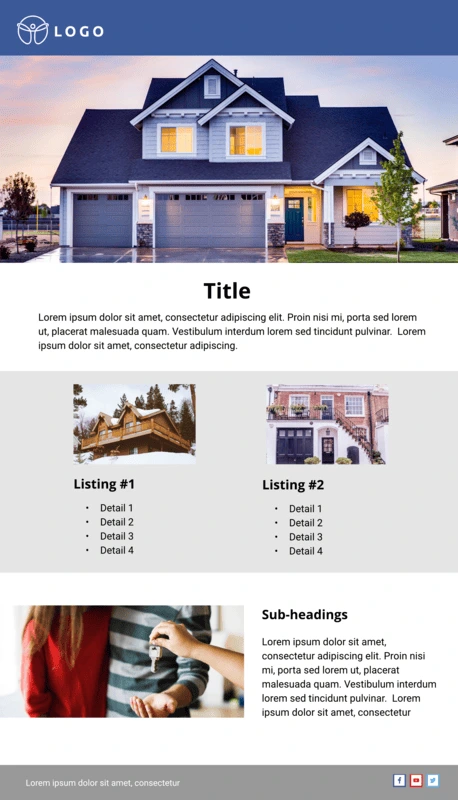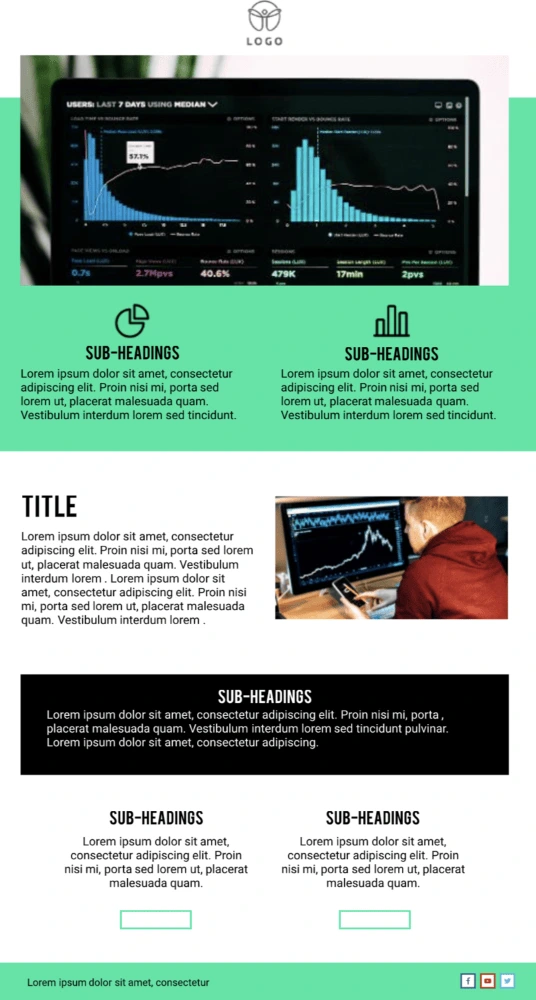Ever wondered how to improve your school or company newsletter? Follow these steps to take your mailing from “Meh” to “Wow!” To follow along and create a newsletter of your own, open the Citrus Splash employee newsletter template in Lucidpress—you can see the demo features right in the editor.
Newsletters are published on a recurring basis to keep readers in the loop. The details of a newsletter will depend on its audience. Above all, newsletters should be informative and add value for readers. Print newsletters focus on text content and are typically letter size (8 ½” × 11”). Email newsletters can vary in layout and size, but should be viewable from both the email message and in a browser.
Open this template in Lucidpress to follow along!
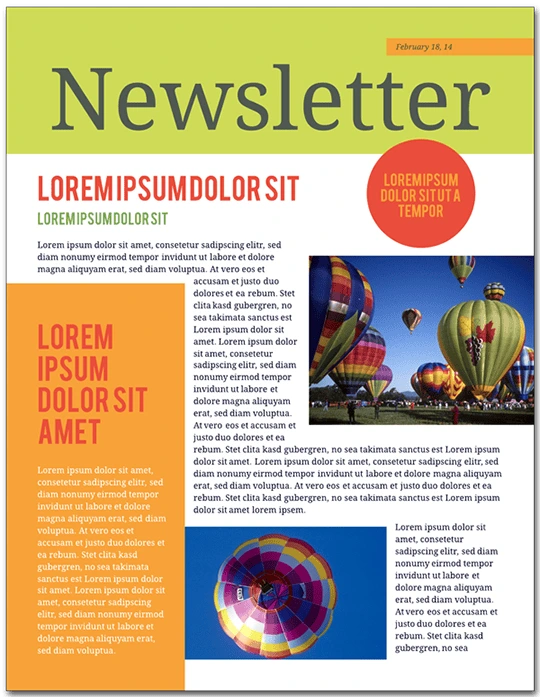
Related: 13 best newsletter design ideas to inspire you
How to create a newsletter
1. Produce good content
Make sure your content is engaging and useful. Don’t add fluff to your writing for its own sake. Before you use design software like Lucidpress, check to see that your pieces are copyedited, your photos are chosen, and your articles’ lengths are set.
This newsletter template is five pages: long enough to include a solid lineup of articles and photographs, but not so long as to be overwhelming.
2. Establish branding
Think about how you will create a consistent brand. Every aspect of your newsletter will reflect upon your corporate or academic culture and identity. Choose a succinct title, incorporate your business’s font (if you have one), and replicate your brand’s color scheme with Lucidpress’ color picker.
To place your logo onto the canvas in Lucidpress, drag the Image icon from the Content bar. From here, you can upload a .PNG file with your company icon.
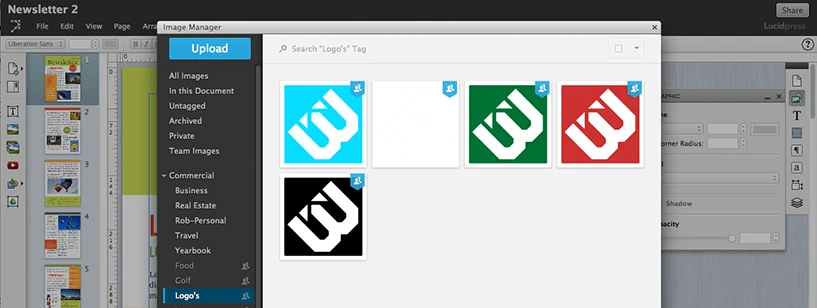
3. Brevity is the soul of wit
It’s important to have a strong opening article. This will often be a message from the principal or director, or a highlight of the most exciting feature in a product. Newsletter articles should be a page or less, with carefully placed images that visually break up the text. Splitting your articles into columns gives your content a suitably “newsy” feel.
On the bottom of page 3, there is a call-out box with a colored background. There are several ways you could use this section of the template for your own content. It could be a mini-article, a call for donations or a caption for the photo above.
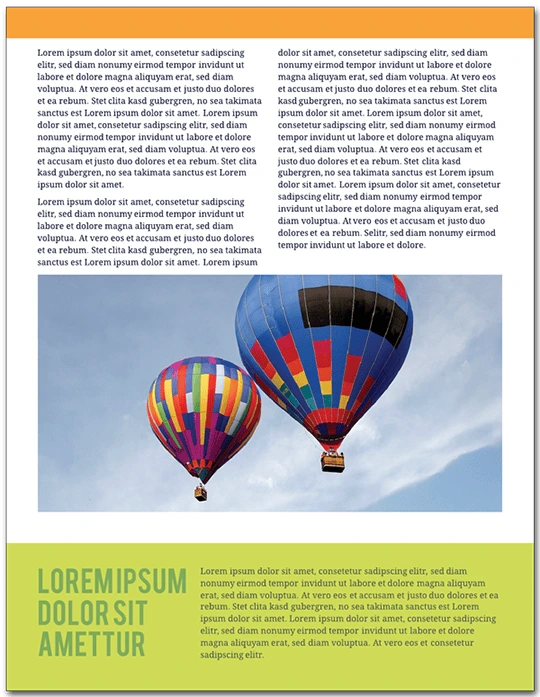
4. Be informative without being too salesy
Newsletters should provide value for their readers. If you used this template for a school, the audience should be able to tell what’s going on for alumni. Avoid too much of the hard sell; consumers are best persuaded with interesting content, not aggressive marketing.
On page 5 of the template, you’ll see an event calendar. To replace the preset dates with your own, double-click the text to edit.
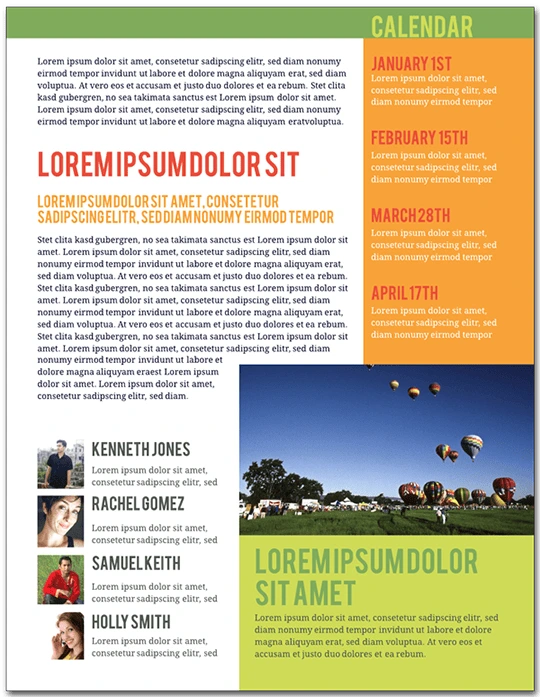
5. Add photos and graphics
This newsletter is tied together by the images of brightly colored hot air balloons. Graphics like these provide visual consistency and make the newsletter fun to look at. A wall of unbroken text is not enjoyable to read, and it will not engage your audience as much as having well-placed images which complement your articles.
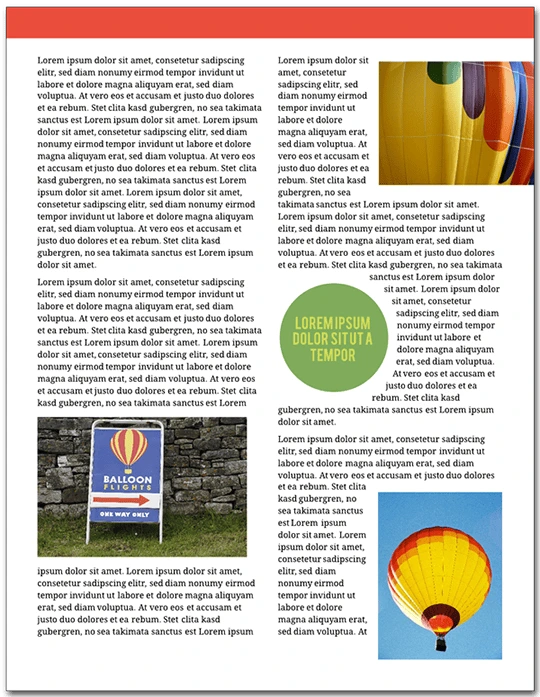
In the template, double-click an image to replace it with your own. This will bring up the Image Manager. From here, you can import images from your computer, Facebook, Dropbox or Google Drive.
6. Optimize your text formatting
Having consistent formatting is essential to your newsletter’s success. Limit the number of colors and fonts—less is more when it comes to readability. In general, use dark text against a light background. Standard usage calls for serif typefaces for the body of your articles, and sans serif typeface for captions, callout boxes and sidebars.
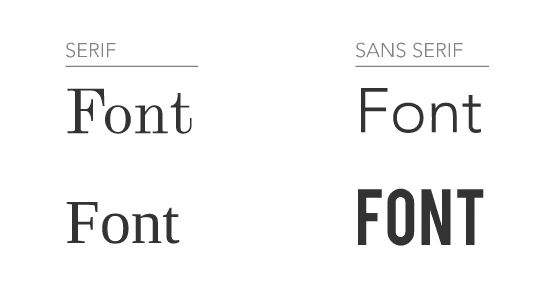
To change the font in Lucidpress, double-click text to select it, then choose a different typeface from the Properties bar. To change the font of every text element at once, press Ctrl+A. The font you choose reflects your brand: aim for consistency over eccentricity. A clean, modern design will earn your audience’s trust more than curlicues and Wingdings.
7. Use interactivity in Lucidpress
Lucidpress makes collaborating on a newsletter simple and straightforward. In Comment mode, your colleagues can weigh in on the content and design of your documents. You can use Lucidpress to invite feedback without the inconvenience of saving multiple drafts—it all happens in the cloud. The following video illustrates how:
8. Proofread your newsletter
Newsletters are text-heavy documents, and a grasp of spelling and grammar conventions will serve you well. Taking a few minutes to proofread your writing will pay big dividends in reader satisfaction.
In Lucidpress, select your text, choose Edit from the Menu bar, and choose spell check. You can also conduct a find-and-replace search for those times when you forget “i before e except after c.”
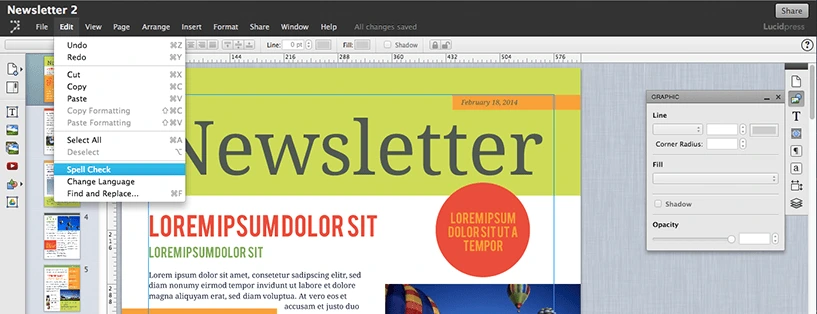
9. Be reliable and consistent
Decide how often you are going to send out your newsletter. This will affect the newsletter’s length, event calendar, and expected features.
Think ahead to the season your audience will receive your newsletter. If you are sending a winter holiday-themed mailing, you have to start designing weeks in advance. The same template can have a very different mood with different color schemes. Try using red and green for December, blue and white for midwinter, pastels for spring, and jewel tones for fall.
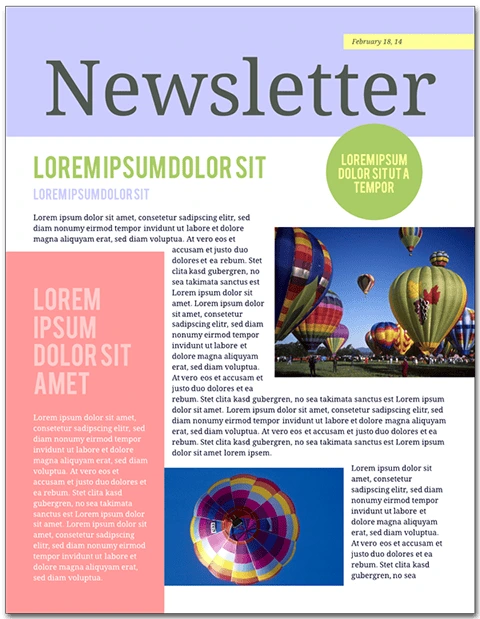
Newsletters are both popular and useful. They extend your brand’s presence, inform and entertain readers, and show off your expertise to the world.
Ready to wow your audience with beautifully designed newsletters? Lucidpress will help you send the right message.
When I was first hired at Lucidpress, I was asked to handle nearly all of our content writing, including the monthly email newsletter. It was a terrifying prospect. Most marketers know that email is a specialized skillset, and it’s easy to screw something up. But not only have we avoided major newsletter snafus, I’ve been able to cut down my time creating a newsletter from one workday… to one hour. That’s a time savings of about 800%, and the newsletters look (and read) better than ever.
Related: How to make a newsletter in 9 steps
So, how did I streamline my process? Here’s how to write a newsletter in three easy steps.
1. Do your homework
I hate starting newsletters from scratch, so I always do research beforehand. If you’re at a larger company, attend important meetings and take notes a few weeks before you start writing. If you’re running a one-man shop, make notes throughout the month. You’ll want to record things like:
- Improvements or updates to your product
- Business initiatives, like a push for more customer feedback
- Random thoughts and ideas like “Are there any upcoming holidays we can capitalize on?” or “Should we start a referral marketing program?”
Always write down a point-of-contact’s name next to your notes so you know who to seek out for more details. As for the third point, you may not use all the random ideas that pop up, but before long, you’ll have a working list of future email campaigns to test.
2. Clarify your goals
Develop a clear goal, and make sure it’s displayed front-and-center in your newsletter. You might be trying to:
- Publicize new features or offerings
- Increase traffic to a store or website
- Boost sales with a newsletter discount or promotion
- Capture customer feedback on your product
- Get subscribers to tell their friends about you
- Remind customers what your product does
- Make an emotional connection with your audience
In all likelihood, you’re trying to do several of these at once. Pick the most important one, and make sure it’s represented at the very start of your newsletter. It should also be presented (in a compelling way) in your subject line. The other major points will fall into place and can often be accomplished without text (think strategically placed links, images and calls-to-action).
3. Make it pretty (and repeatable)
Now that you have notes and a clear goal, you can easily write the text of your newsletter. The most important step here is to format your text for maximum readability. You’ll also want a nice-looking layout that communicates your company’s professionalism. Here are my tips for making it happen in under an hour:
Distribution
Ask yourself where your audience is, then decide on your method of distribution. You can go old-school with a printed newsletter or distribute your content digitally; the latter is more common nowadays. Lucidpress’s company newsletter templates allow you to quickly build a professional-looking newsletter, then print or share with a URL. All of our templates can be customized to make school newsletter templates, Christmas newsletter templates and more.
You can push out the link via social media or a website, but remember that you’ll still want to use a dedicated email service to email it. That way, you don’t have to handle subscribes/unsubscribes, CAN-SPAM compliance, and other time-sucking aspects of email management. I’ve had good experiences with MailChimp and Hubspot, but there are many others to choose from.
Here’s how a Lucidpress newsletter looks when you embed it in MailChimp. Pretty snazzy, right? We generate the code for you—just copy and paste it in.
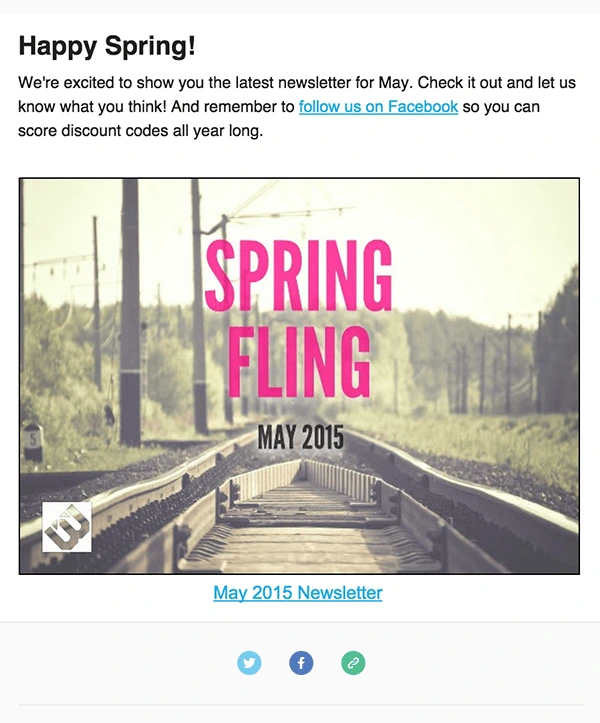
If you’d rather build a newsletter with HTML than embed a Lucidpress newsletter, pick an email service that offers prebuilt layouts. If you can’t do that, enlist the help of a professional web developer to create a few plug-and-play templates.
Text formatting
Lead with items that have the broadest appeal to your audience.
Keep it short, unless you have a good reason to do otherwise. My newsletters rarely exceed 400 words and are usually closer to 200.
This email from MURAL is a great example of how to use text sparingly to get your point across. The copy is brief and easy to read, while the images are carefully positioned to support the text. It all adds up to a highly consumable newsletter.
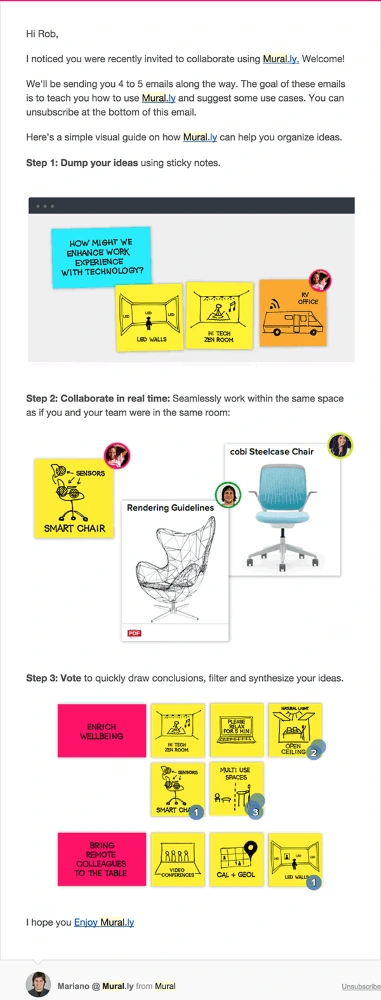
Design
Break up the text with relevant images, buttons and links. Use enough negative space to let all of your design elements breathe. This example from Litographs shows how striking a clean, roomy design can be.
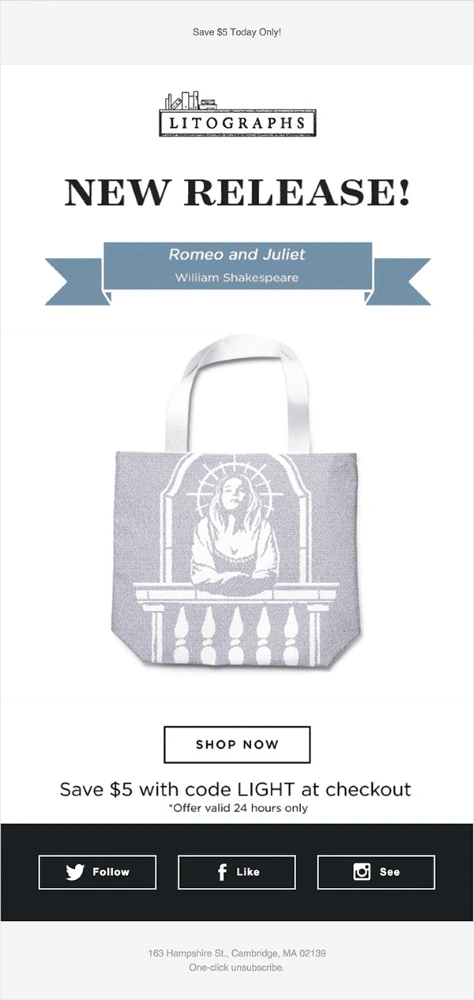
And that’s all, folks: how to write a newsletter in less time than ever before. We’d love to hear your own tips for maximizing effectiveness in marketing—just leave them in the comments.
Ready to make your own newsletter? These free newsletter templates are a great starting point.
A well-constructed digital marketing campaign can offer limitless possibilities for businesses who are open to implementing new, proactive strategies to go along with their most-revered traditional ones. After all, mixing up some old and new campaigns can bring interesting and promising results to data-driven businesses.
Among the most cost-effective ways to build and maintain a connection with your audience is through an email newsletter program. Yes, those recurring emails you’re used to receiving from your favorite brands and personalities can also be a catalyst for your own brand’s long-term success.
Related: How to make a newsletter in 9 steps
It’s easy to set up, too. For example, newsletter software like ActiveTrail’s email marketing automation platform (which offers newsletter templates and a responsive email editor) can be a great complement to the visuals you design in Lucidpress. But in any case, if you’re not yet implementing this strategy, here are 4 reasons to set up your own newsletter program soon.
Stabilize the flow of information
Your website and blog might offer the best content on the internet, but the thing is, most online visitors will still rarely spend more than a few seconds on any webpage. That’s why a proactive support system should be in place to keep people coming back. Remember, a blog often requires people to initiate contact, and as a business, this behavior can translate to inconsistent returns. But if you have an ongoing newsletter campaign, you can conveniently reach out to your customers and drive further engagement. By giving your audience instant access to promotions, new products and other updates, people will have a much easier time understanding what your brand can do for them.
Increase brand awareness
A newsletter can carry a substantial amount of information, making it easier to create awareness around your products and services. By proactively sending out new messages, customers and prospects will come to feel your brand is familiar and will think of it more often. It’s an efficient and consistent way to remind people of your presence, and if your content is timely and compelling, it’ll drive your audience to act.
Connect with new prospects
It’s no secret that people love to window-shop online. Much of the time, people are passively looking for products and services that they want, but they simply don’t have the time, money or right reason to buy now. A newsletter that provides prospective clients with valuable information helps them make favorable decisions when the right time comes. Use your newsletter to prove your expertise and stay in touch with potential customers until they’re ready to strike a deal.
Keep existing customers in the funnel
You lose some and you gain some. But how about gaining more? Companies can never completely eliminate churn, but a thoughtful newsletter campaign can certainly reduce the risk of annoying your recipients. By keeping them in the loop, getting their feedback, and introducing them to your latest offerings, customers will feel like you have something more to offer and that you’re consistently improving your services. The more you stay in touch with customers, the more likely they’ll feel valued and appreciated. []
Are you feeling inspired and optimistic about starting your own newsletter campaign? Don’t wait—roll out a program now and keep the deals coming in, not only from your existing customers, but from the thousands of prospective customers out there.
Here’s more than a dozen free newsletter templates to help you get started.
Choosing the right newsletter design isn’t easy. There’s a seemingly infinite number of designs out there, each with their own strengths and weaknesses. (And in many cases, more weaknesses than strengths.) Finding the right colors, shapes, text formats and image placements can take up a huge amount of time.
But with these professionally designed newsletter templates, all you need to worry about is customizing. The designs are already in place, suggested color palettes chosen, and even some images added (though adding your own is recommended).
Related: How to make a newsletter in 9 steps
Newsletter design tips
There’s a few principles to keep in mind as you concoct your newsletter, even if you start with a pre-existing template. Though, in the end, you’ll have a fantastic-looking newsletter in less time than it will take to find a template from Microsoft Word or Publisher. Your readers will thank you. Also, it’s worth noting that we’ve organized this blog post based on newsletter type — i.e., newsletters for schools, businesses, holidays, digital and more.
Consider the layout type
As in — do you want your newsletter to be: fixed, fluid, responsive or adaptive? To avoid overwhelming you with information (and empowering you to learn on your own terms), we recommend checking out UX Alpaca’s article on layout types.
Grab attention with a header
Let your header do the talking for you. Your header should do one of two things (or both): First, it should draw the reader in. Copy can be witty and sharp, or directly address a pain point you know they have. Either way, you need to grab their attention and endeavor them to keep reading. Without telling them to keep reading. 2.) You need to say something. There’s an approach to copywriting that can be best summarized as “Say it straight, then say it great.” But whatever you do, it has to say something of substance.
Let your body copy do the ‘splainin
Remember: Your header doesn’t have to carry the weight of your newsletter — body copy can come in with the assist. The body copy is where important information should live. How you choose to present that is up to you, but keep in mind that big walls of words can be overwhelming for readers, so we recommend keeping the information as scannable as possible.
Add relevant links where it’s appropriate
The devil is in the details, right? Be sure to include links to webinars, listings, school flyers and more. If you want people to show up, you gotta give them a reason to show up! Or whatever.
Newsletters for schools
Skyline High classroom newsletter template
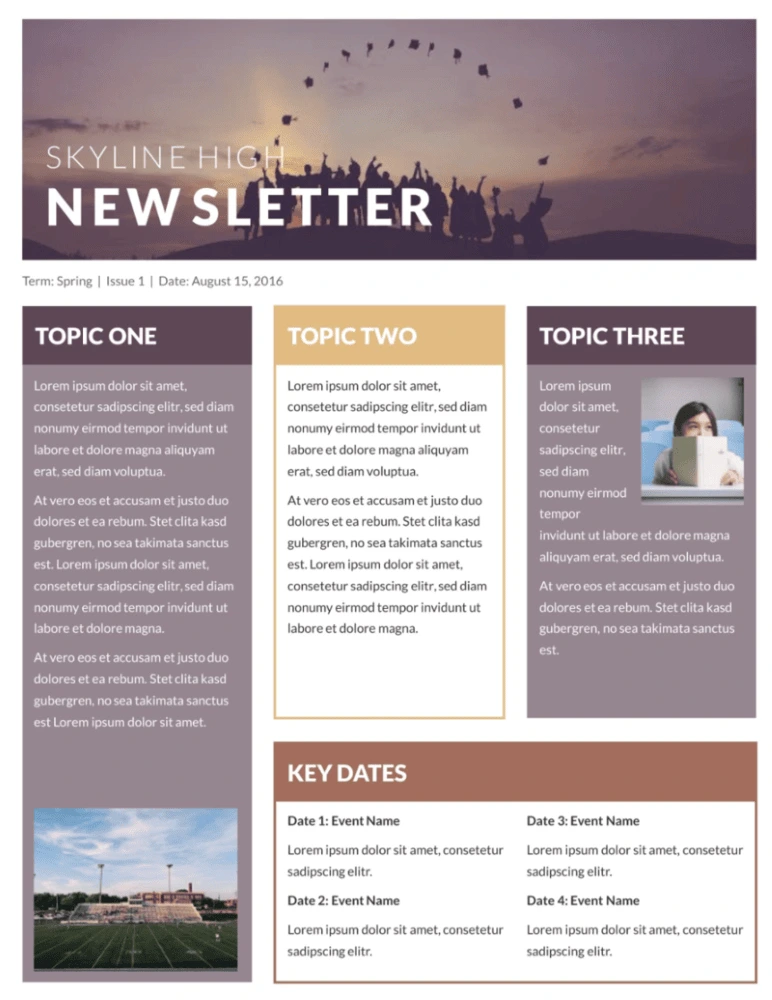
This classroom newsletter template stands out from the rest with muted colors, an inspiring header image, and lots of room to share your message. Whether you’re simply giving updates on what’s happening or sharing important news about conferences, exams or standardized testing, your message will come across loud and clear.
Blossoms school newsletter template
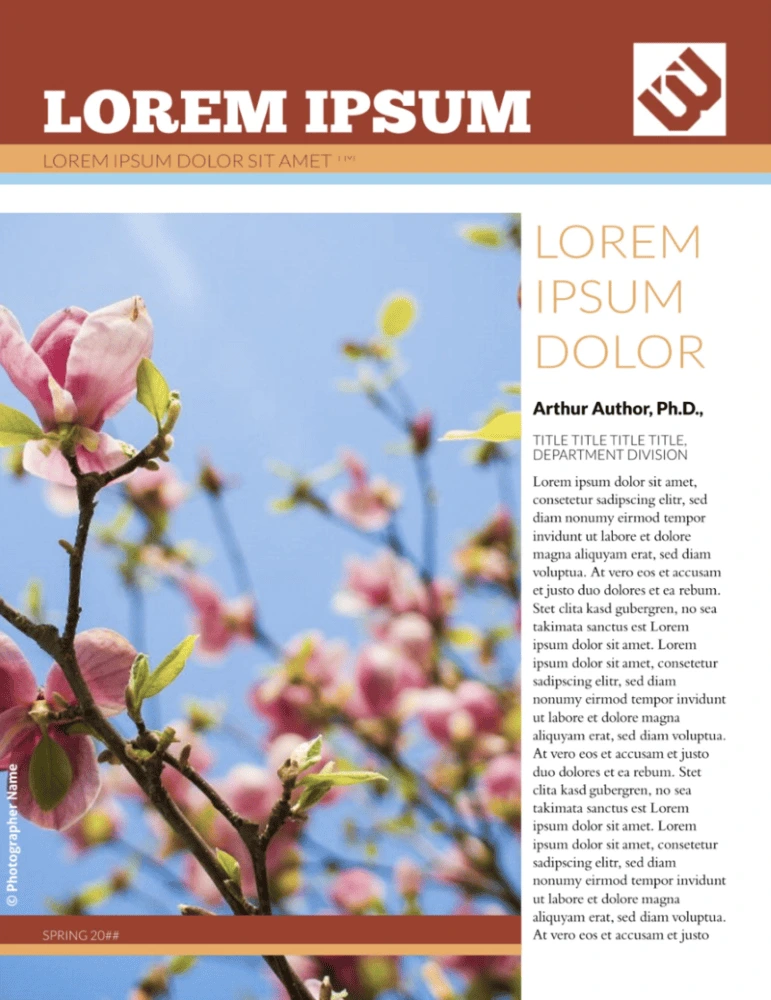
Flowers are perfect for school newsletters: they imply growth, potential, purpose, and they lend a positive, happy feeling to everything. Just add your school’s logo, the content of your newsletter and a few custom images, and you have a newsletter that parents will want to read.
Newsletters for business
City events newsletter template
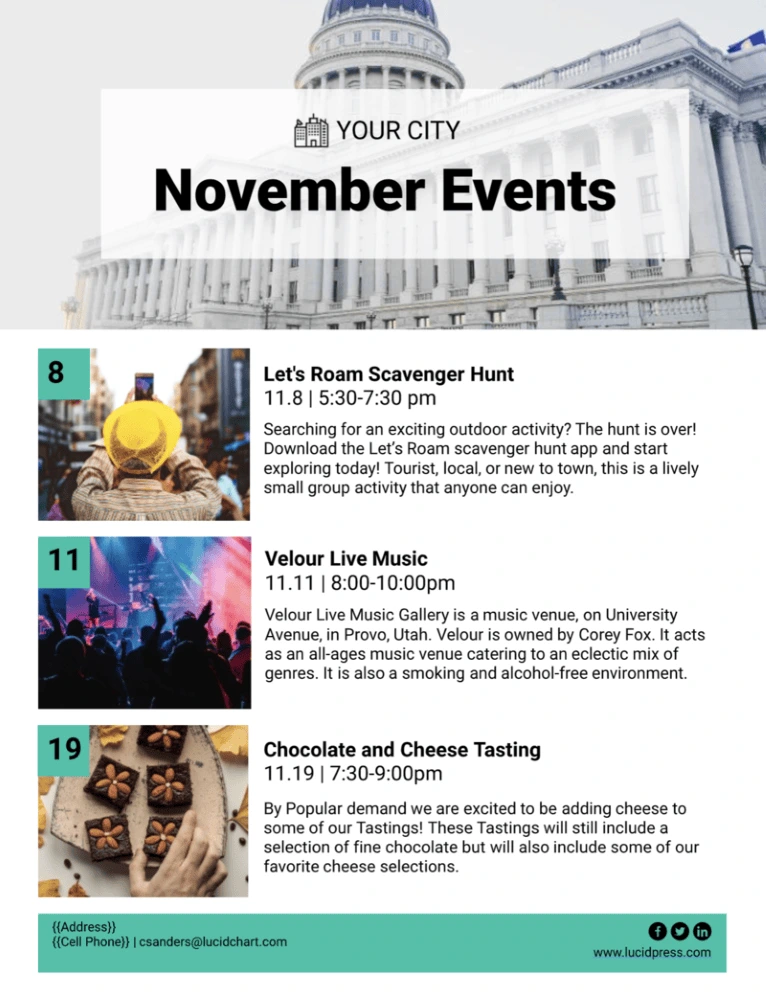
Keep your community apprised of upcoming events — both virtual or in-person — with the city events newsletter template. Insert photos from previous events (as well as your own city hall building or town committee) — or use stock images if you need to — and leverage the ample writing space to communicate with others about changes in local regulations, upcoming town halls and more.
Polaroid real estate newsletter template
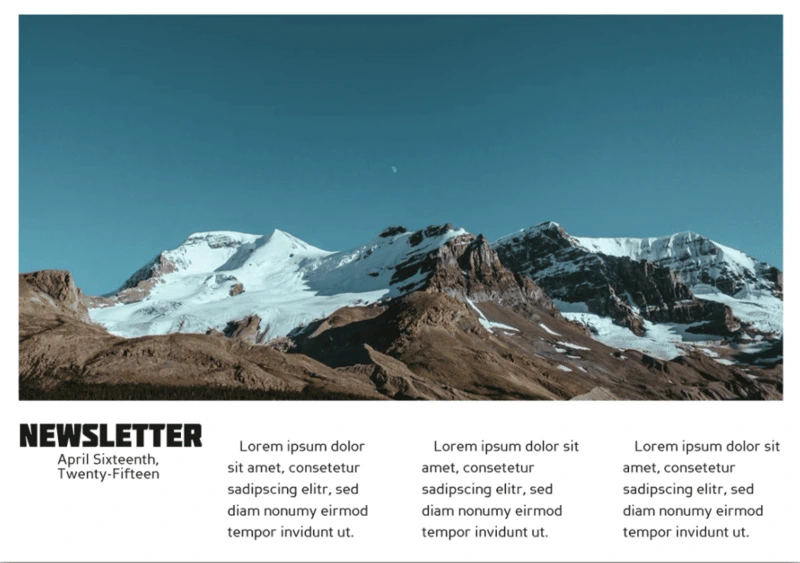
Real estate is all about pictures, and this newsletter template captures that feeling perfectly. The iconic rectangular format gives you tons of room to show off your best properties, and choosing a scrollable digital format allows for all the text you need to describe it. Optional blocks of color help your newsletter stand out from the rest, too.
Merge financial business newsletter template

The time of boring business newsletters is over. Modern companies need to grab readers’ attention with bold colors, interesting shapes and arresting images. This financial business newsletter design has all of those ingredients in spades. The newspaper-style columns let you share different stories or ideas, and the header is great for recurring newsletters with featured authors.
Black Widow company newsletter template
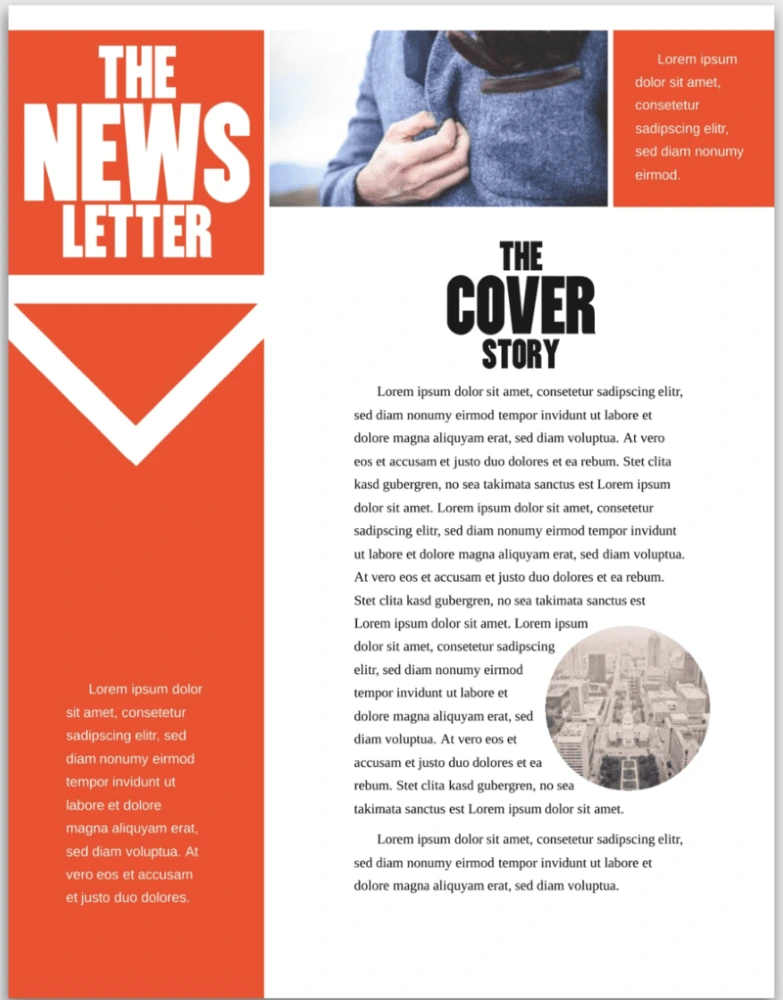
Company newsletters are often bright and airy or monochromatic and, well… boring. But this template finds a balance with bold red accents, striking blocks of black, and plenty of whitespace to make reading easy. Add images to spice things up a bit, and you have yourself a professional — but unique — newsletter template.
Citrus Splash employee newsletter template
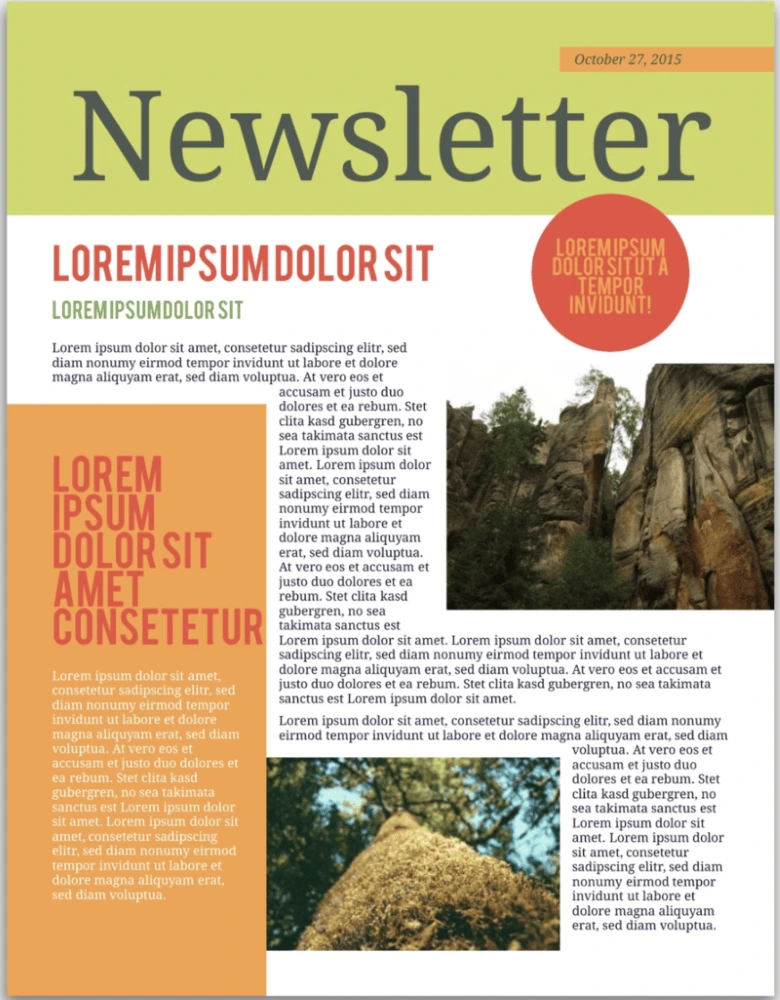
Employee newsletters have a reputation for being rather boring—and that starts with the template. Don’t settle for bland colors and cheesy iconography! This template is full of bright colors that immediately set a positive tone for your newsletter. Whether you’re in a tropical climate or a temperate one, your employees’ days will be brightened by it.
Angles company newsletter template
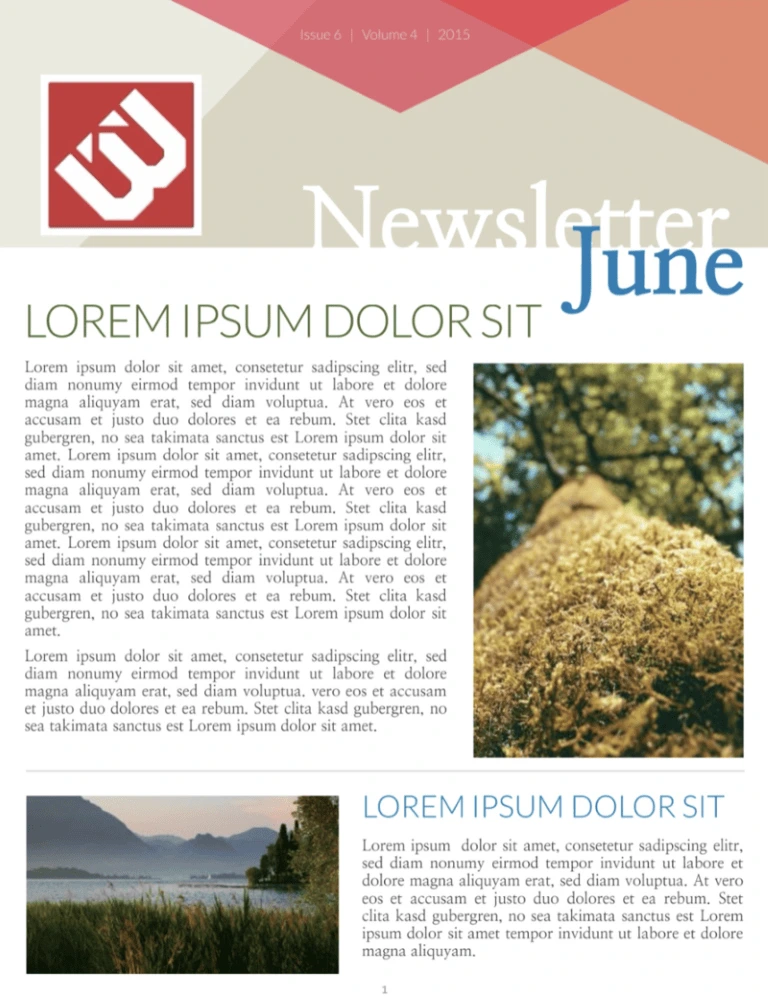
There’s something dynamic about angles in bold colors—and this newsletter template takes full advantage. A combination of bright and calm tones adds even more energy to the template. If your company is pushing forward, the vitality in this template will fit it perfectly. Plenty of room for images and multiple text sections make it as useful as it is engaging.
Bold business newsletter template
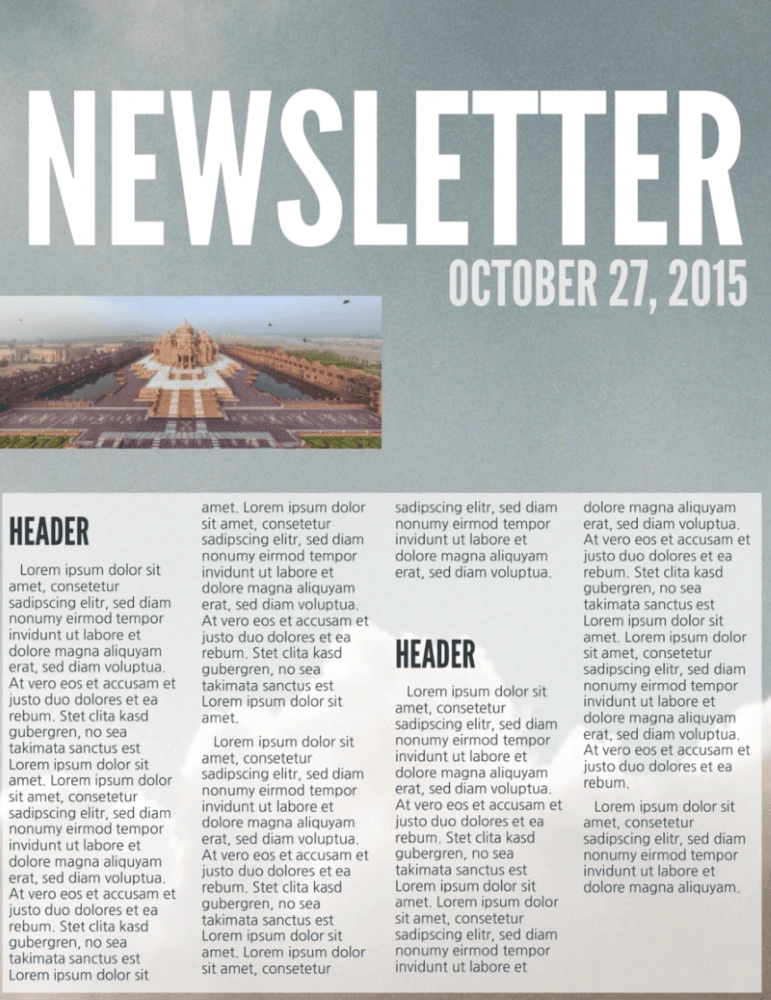
Business newsletters are so often really boring, but with big attention-grabbing text, this template will help you grab your readers’ attention. It’s not all flash, though—there’s plenty of room for the headlines and text you need to share important information with customers, colleagues, shareholders, and anyone else interested in your business.
Corporate business newsletter template
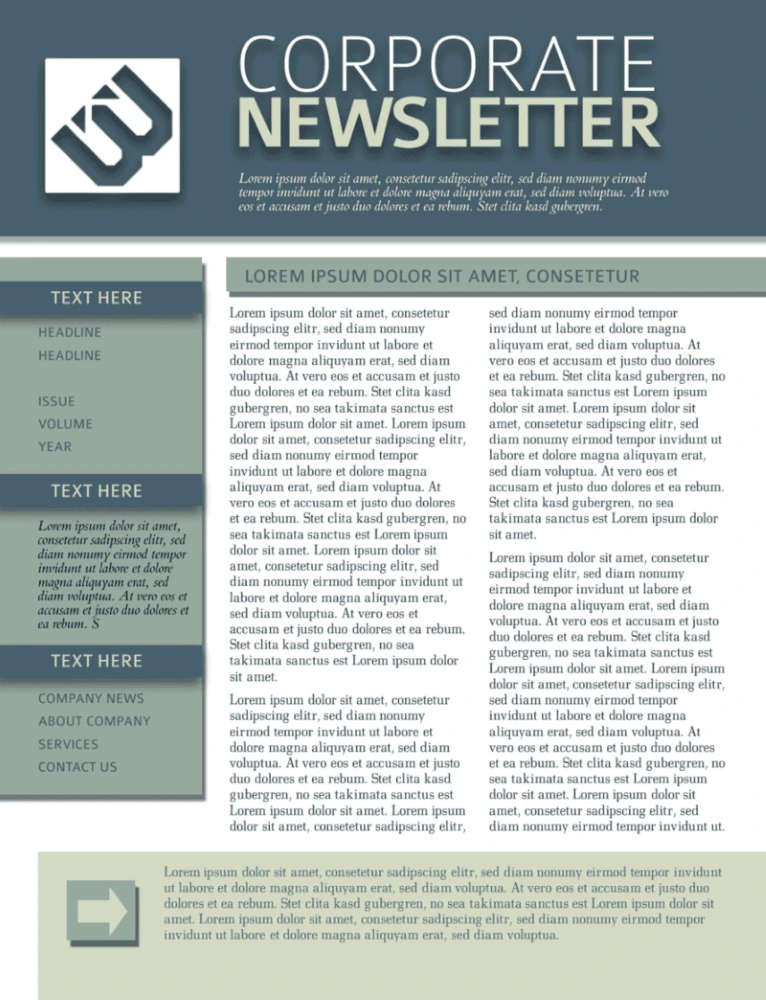
We know that not every company wants lots of bright colors in their newsletter template. But that doesn’t mean it has to be boring. This template uses a cool, muted palette to maintain a professional look. The professional design, room for images, and well-laid-out pages ensure that your newsletter shares information effectively while maintaining the tone you’re looking for.
Holiday newsletters
Holiday Christmas newsletter template
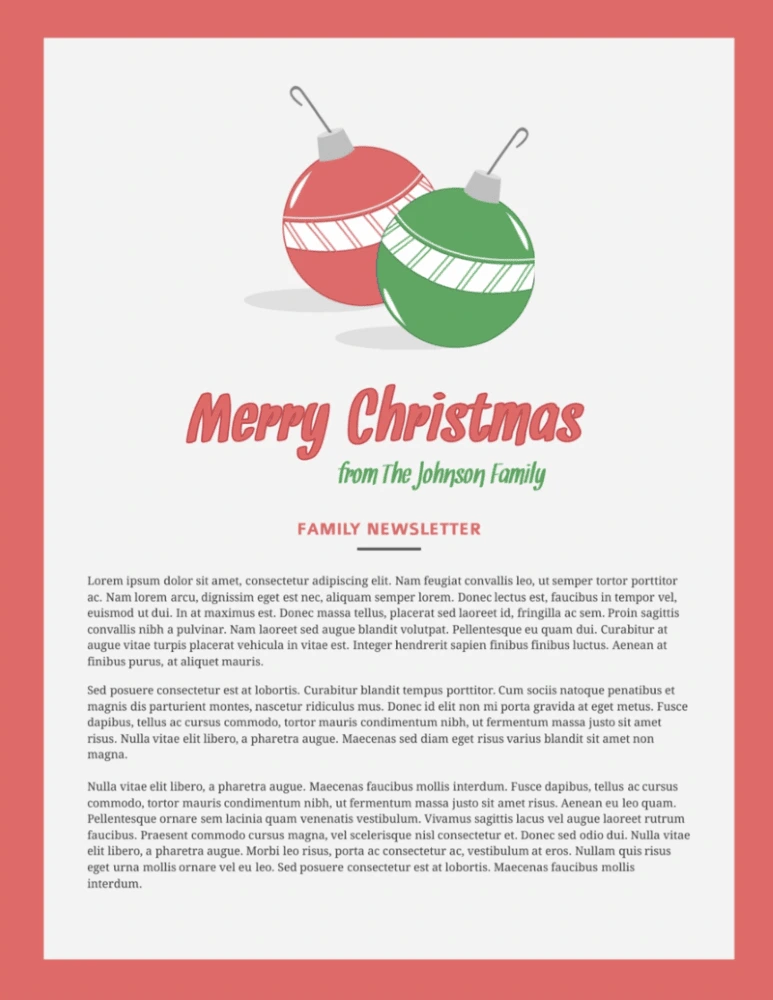
There are tons of Christmas newsletter designs out there, but most of them look the same: full of too many snowflakes, baubles and presents. They’re distracting and, frankly, a bit tacky. This Christmas newsletter keeps things simple with seasonal colors, clean layouts, and just a few ornaments.
Photo Christmas newsletter template
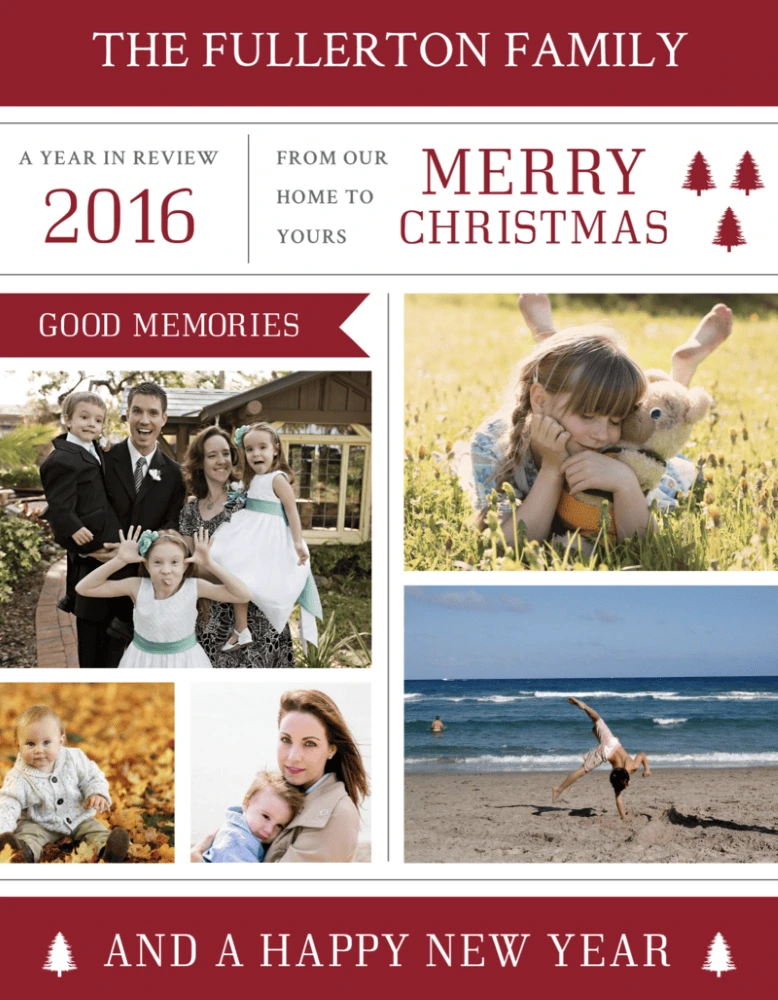
Spread some holiday cheer with the photo Christmas newsletter template. Just pop any of the year’s recent photo sessions (both impromptu and professional) into the layout, and be prepared to warm friends’ and families’ hearts from afar.
Digital and email newsletters
Restaurant email newsletter template
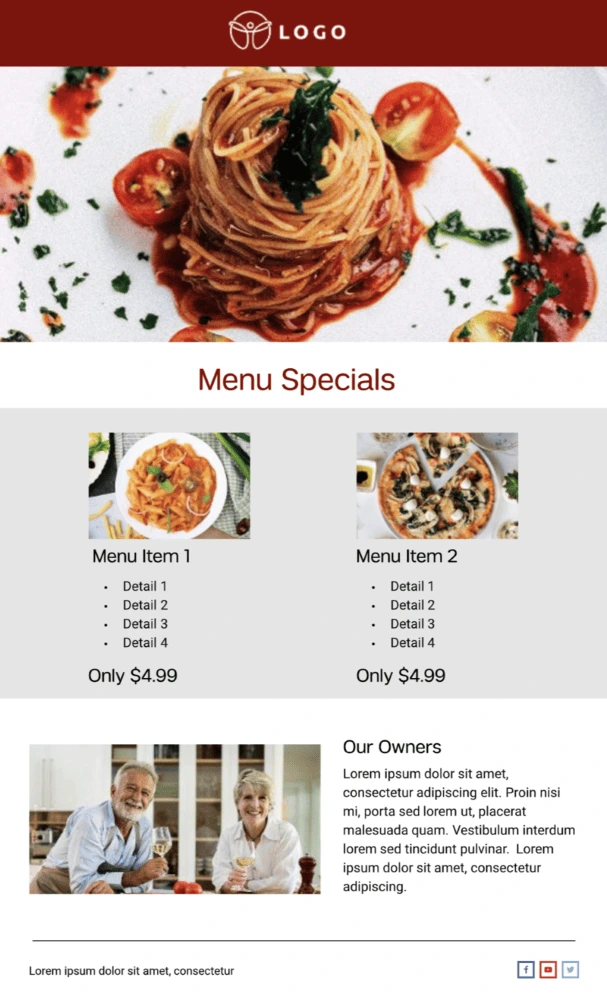
The restaurant email newsletter template is :chef’s kiss: — Highlight your restaurant and the staff that make everything possible with this easy-to-customize template. You can easily communicate any upcoming closures, events or changes in menu. Or you can simply give folks a mouth-watering reason to come back with a coupon or friendly reminder about your hours.
Conference email newsletter template
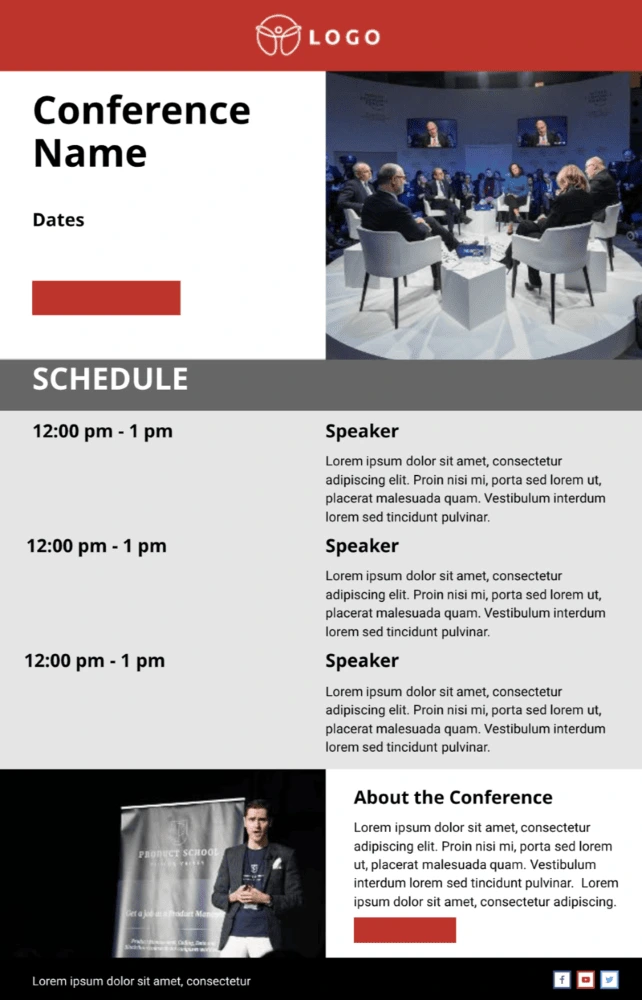
When it comes to attending conferences, attendees need you to get straight to the point — there’s no need for fancy, floral language or walls of text. Give the people what they need with the conference email newsletter template. The simplicity of this newsletter empowers you to cut to the chase, therefore keeping the agenda and end goals clear and concise.
Real estate email newsletter template
Need an easy way to keep clients, brokers and fellow agents up-to-date with the fast-moving market? Look no further than the real estate email newsletter template. Customize the images based on the MLS listing, along with any noteworthy callouts in the copy sections.
Data email newsletter template
Highlight important wins, transformations in ROI or dips in sales performance with the data email newsletter template. Whatever numerical information you need to present, this newsletter helps you compile the information in an orderly and easy-to-digest format. And if you need to send the newsletter out monthly, all you have to do is make a copy of the doc and you’re off to the races!
Business email newsletter template
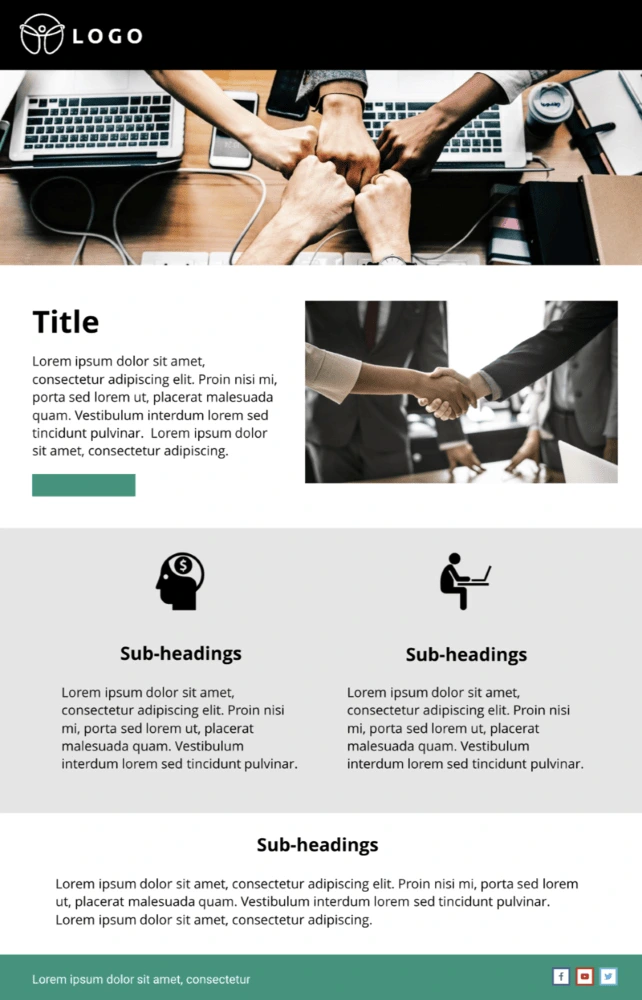
Regardless of what arena or industry you’re in, keep your business top of mind with the business email newsletter template. Whether you’re looking to periodically update board members, customers or even fellow colleagues, this easy-to-customize newsletter template.
Terra Cotta digital newsletter template
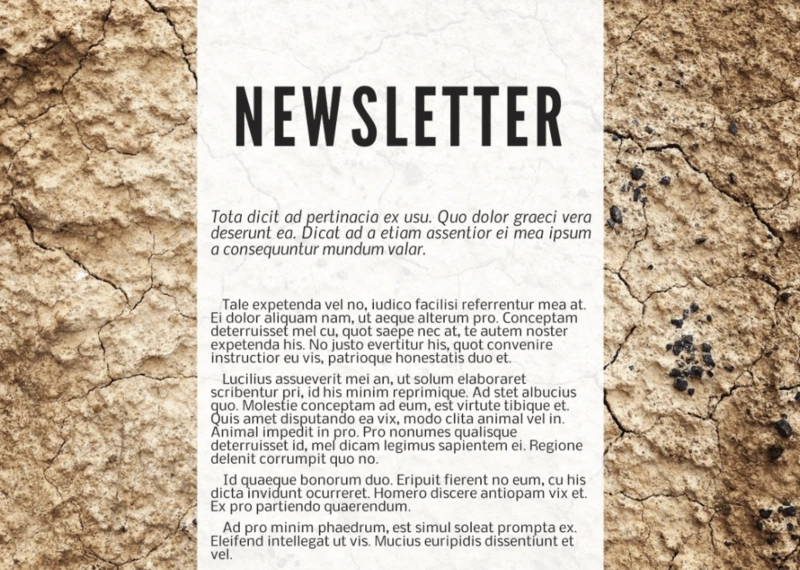
Digital newsletter designs don’t have the same requirements as print ones—they can be more image-based, use different colors, even include scrolling effects. This template allows for a wide variety of designs, all of which capitalize on ample space for powerful images. Combined with clear text and the ability to add your own images and videos, you can share any information you want in a clear, visually appealing package.
Orbital digital newsletter template
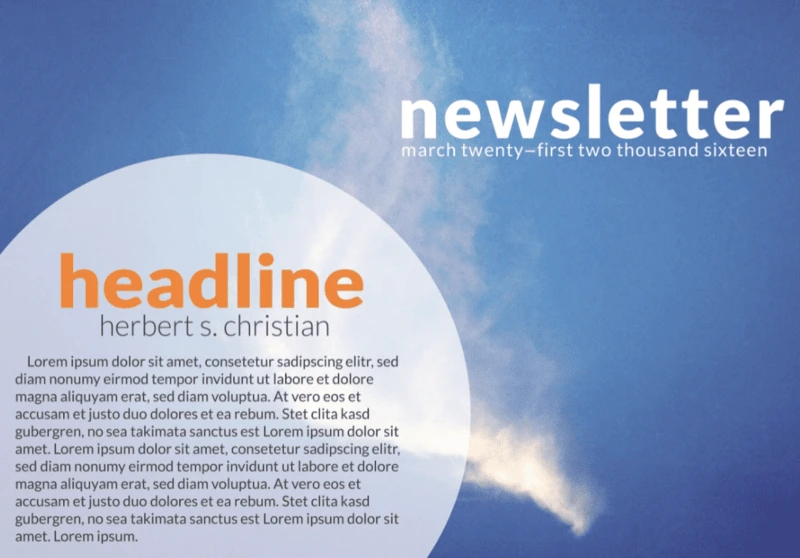
This template is all about creating the right feel with a big, powerful image. Whether you use one of our images or upload your own, you’ll be setting the tone for your entire newsletter. It could be inspirational, topical, or just an image that speaks to you. And because this digital template has room for scrolling text, you can include as much information as you want. That makes it one of the most flexible and versatile templates out there.
Textual e-newsletter template
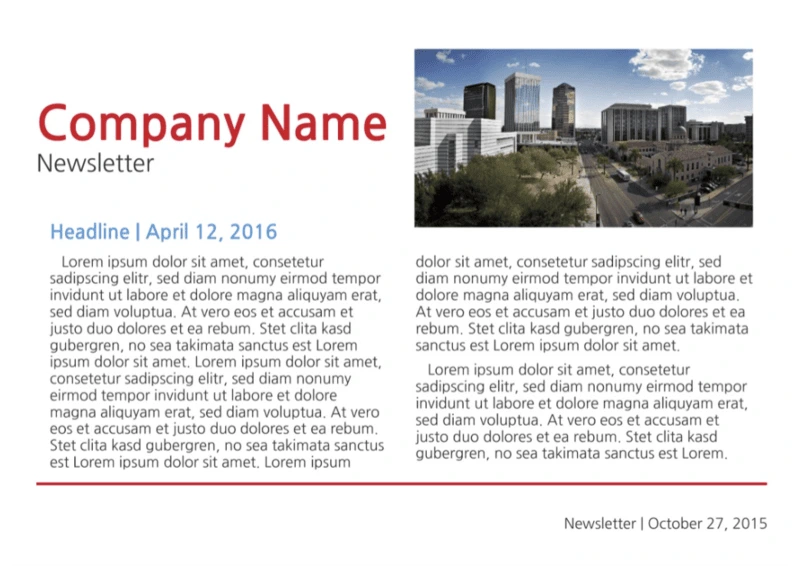
It’s easy to get carried away with images, photos, links, and other distracting things when you’re building an e-newsletter. It’s important to remember that your main goal is to share information in an easy-to-read manner. The clear fonts and white background of this template let you do that without over-complicating things. Sometimes simple really is better.
Be a memorable point of contact
A newsletter is an important point of contact. Whether you’re designing one for a school, a business, another type of organization, or just for your family and friends, you want it to reflect your message. These designs give you a wide variety of looks to do just that
So, what are you waiting for? Find a template that fits the feeling you’re going for, customize it in a few minutes with your own photos and colors, and get your message out there in style.
Ready to wow your audience with beautifully designed newsletters? Lucidpress will help you send the right message.
Email marketing is a huge sales driver for e-commerce companies. Social media is also a great tool, but those sites measure their users in the millions while email providers measure theirs in the billions.
According to a study by The Radicati Group, there are approximately 3.8 billion email users worldwide. That’s more than the estimated 2.77 billion from all social media outlets combined, according to Statista in 2017.
Related: 11 things to consider before your next email campaign
Because so many considerations go into a good email marketing campaign, there are plenty of opportunities for things to go wrong. Fortunately, there are tools available that make the heady world of email marketing far less complicated. Here’s a round-up of our 8 favorites—and let’s start with the one closest to home.
1. Lucidpress
When you’re getting started with e-commerce, one of the hardest parts of email marketing is finding a template that works well. Unless you’re particularly artistic, it’s hard to envision a good format that’s both practical and visually appealing. That’s where Lucidpress comes in with a line of free newsletter templates.
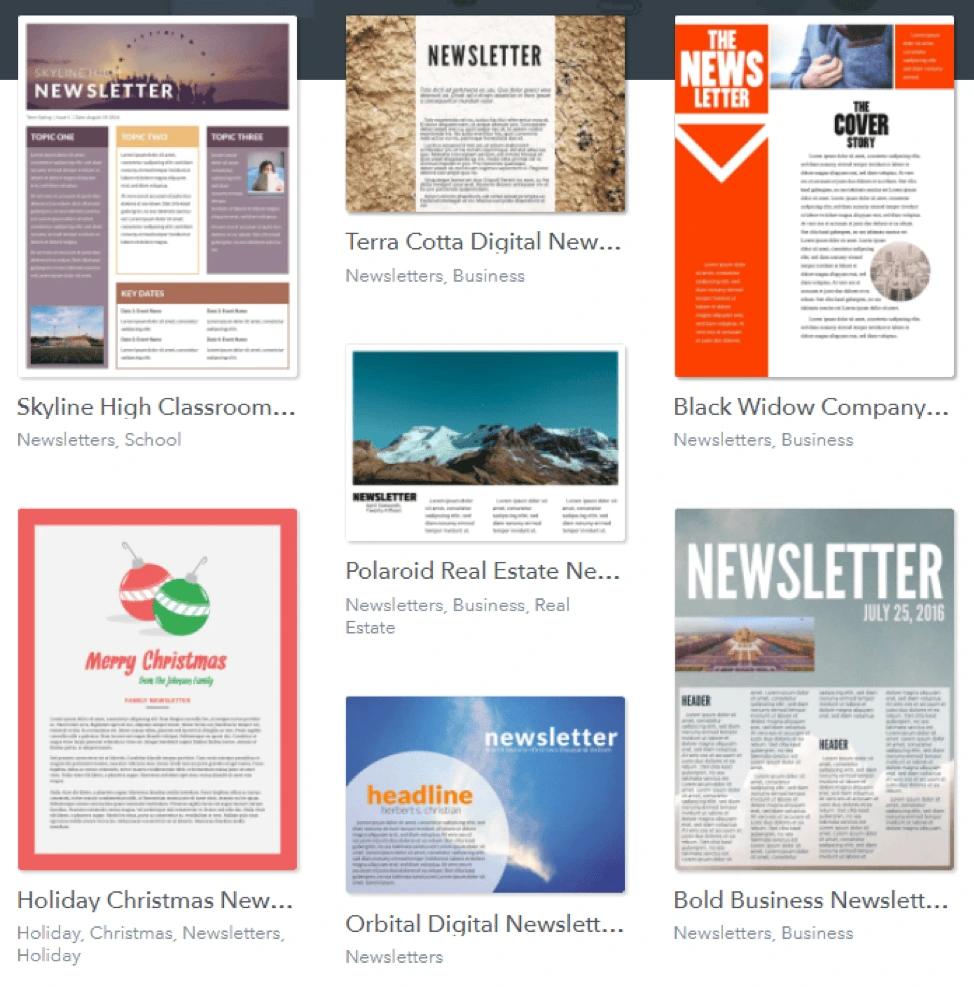
Not only does Lucidpress provide plenty of newsletter ideas for your inspiration, but it takes very little time to get started. Its drag-and-drop design platform is dead easy to use, and you have a variety of options for sharing your newsletter: downloading it, embedding it, or generating its HTML code. And because it’s free, new e-commerce companies can save the time it would take to come up with their own style—and the money they might have spent for the same service.
2. Constant Contact
Constant Contact effectively organizes and personalizes the emails you send out to customers. If you look at their website, you’ll see examples of email messages for welcomes, birthdays and membership anniversaries.
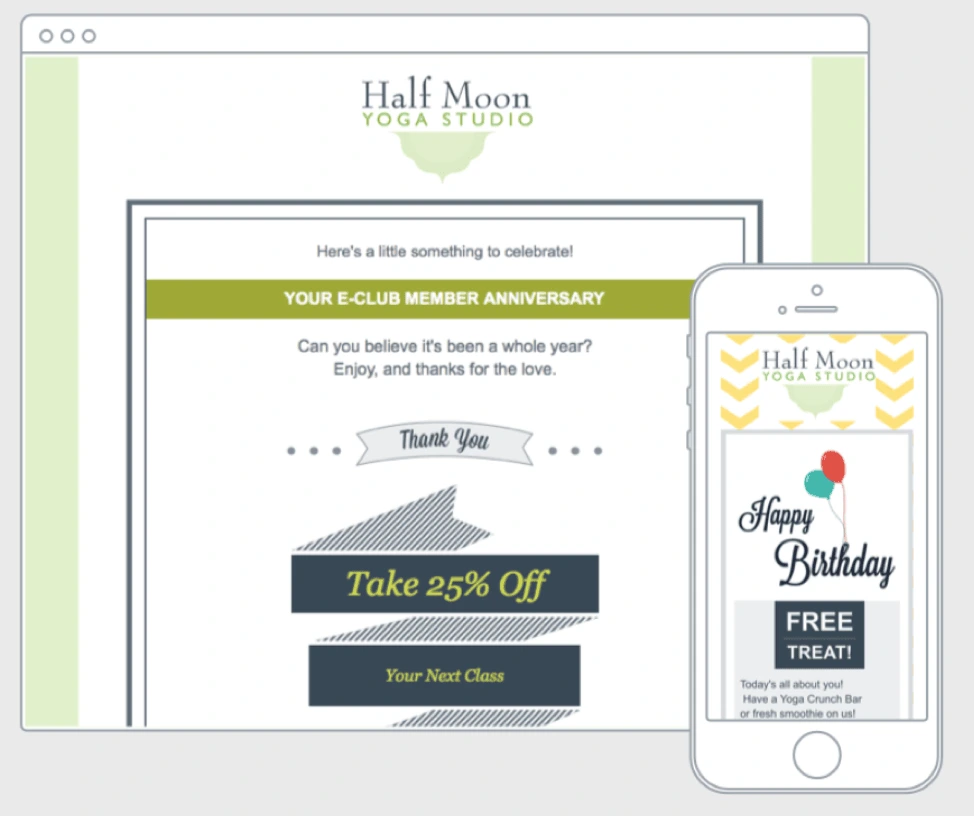
You can track the success of your emails in real time, seeing just how many people are clicking through your links and taking action because of your email.
3. The Hemingway App
Having the right format, fonts and style is crucial to a good email campaign, but in the scramble to get all that right, it’s easy to overlook the actual words that will be in the email. The Hemingway App is there to make sure your writing is concise and easy to understand.
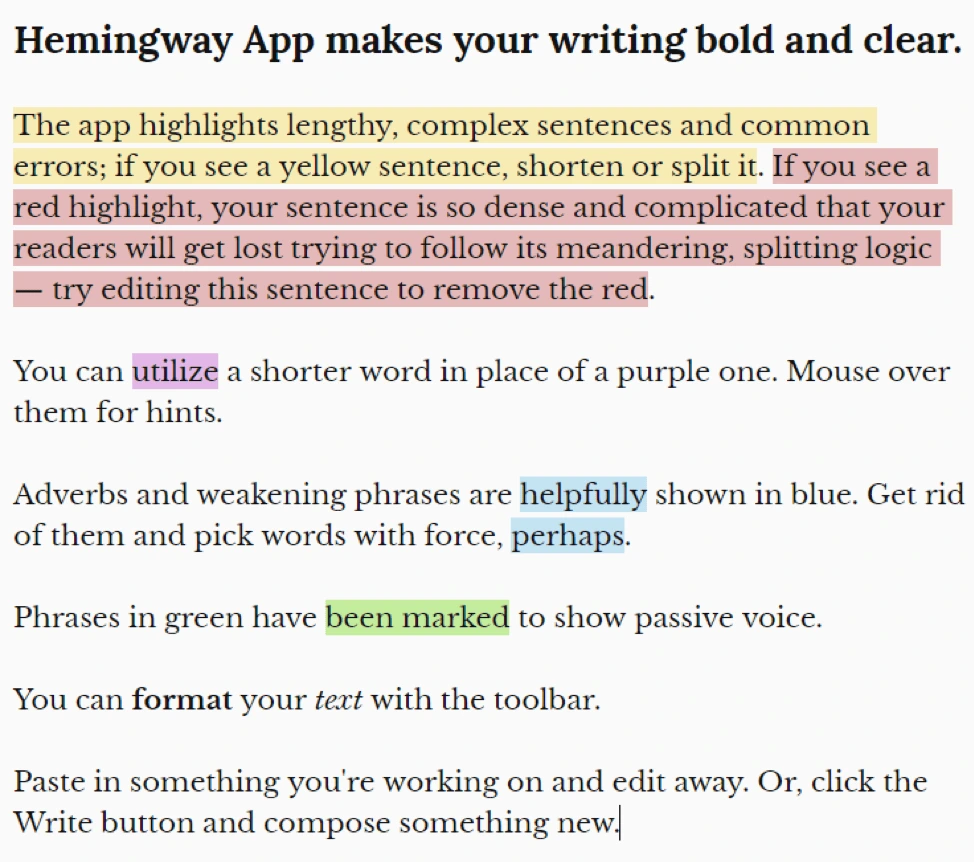
Being clear and concise is not always easy. As a brand marketer, you know your products in and out, including niche vocabulary. And while some customers will appreciate the jargon, others won’t. Instead, they’ll be confused or disengaged when reading your emails. Hemingway helps you write email copy that anyone will easily understand.
4. MailChimp
MailChimp bills itself as the “world’s largest marketing automation platform.” Using it, you can mix and match different aspects to essentially create your own email templates.
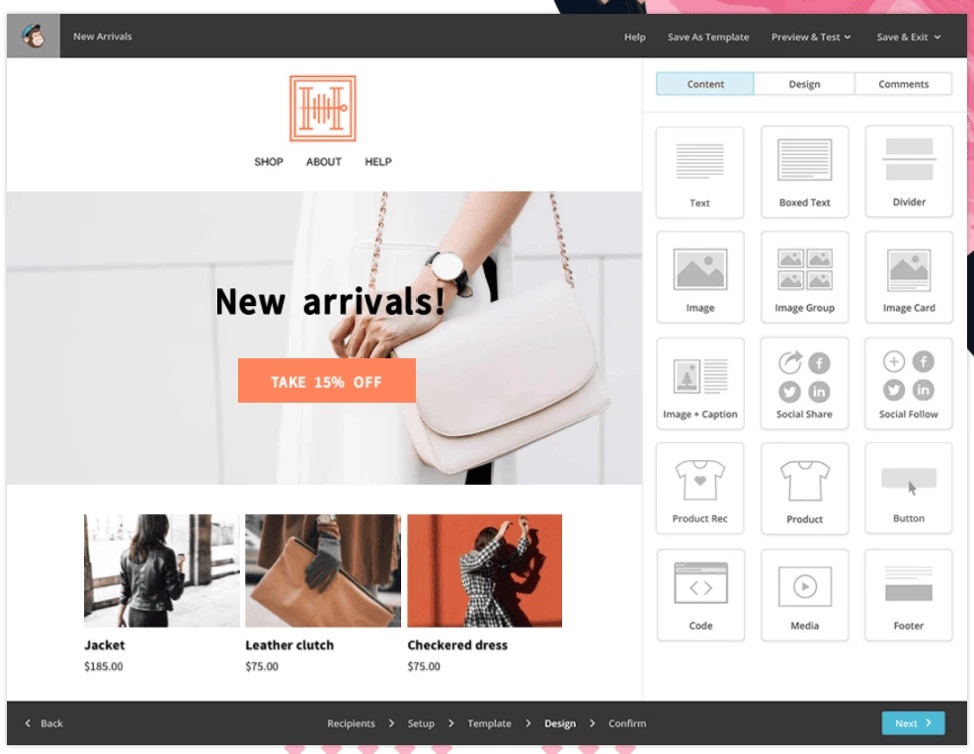
It has more than just templates, though. There are also automation tools that the service uses to “welcome, re-engage and follow up” with customers. Having said that, it’s a fierce competitor to Constant Contact, so you’ll have to compare them both to decide if one is right for you.
5. AWeber
Alongside automated emails and responses, AWeber has a feature that triggers certain emails based on which links subscribers click on. Generally, you’ll trigger emails for everyone, but for some, when they look into the promotions you send out, AWeber can help you automate follow-ups.
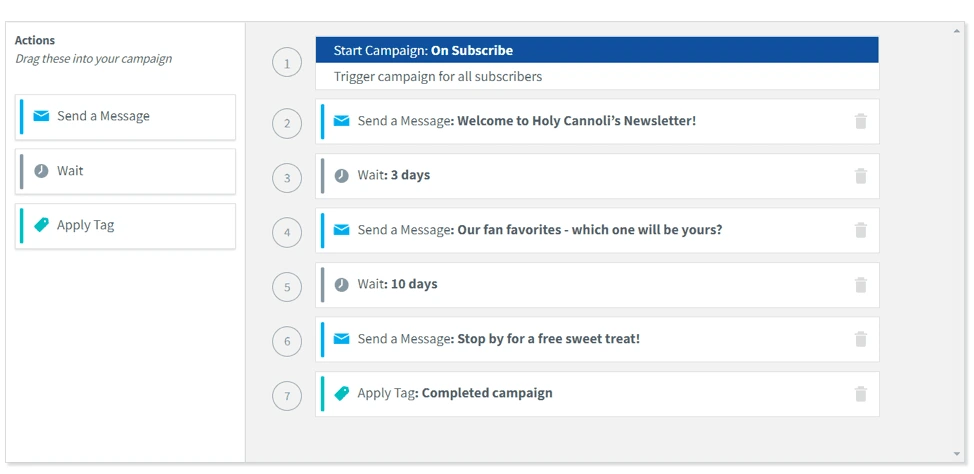
Like many others, personalization is a big priority on this email marketing platform. Putting in people’s actual names (instead of something generic like “Valued Customer”) and tweaking emails to reflect personal preferences are the little extra touches that make these tools worth the money.
6. GetResponse
Automation is a huge time-saver, and that’s where GetResponse puts its focus. To them, automation isn’t just about sending mass emails. There’s a whole world of communication built on how to respond to emails and when to send them.
Every customer is different, and people are more likely to engage with emails at different times. GetResponse can track these things for each person and send them emails at the best time for them.
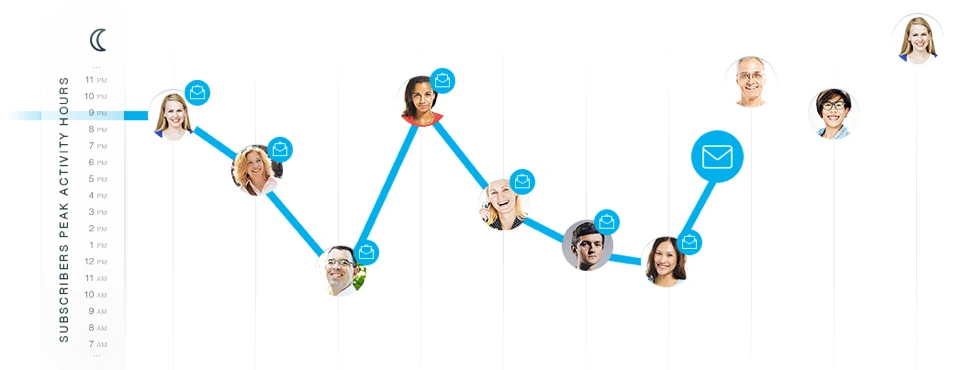
One of the keys to effective marketing is knowing your audience. It’s little details like these that can make a small but notable difference in how well your email campaigns do. If they don’t seem to be working, a simple tweak in timing might make the difference.
7. Answer the Public
This is a unique tool that can help you generate newsletter ideas surrounding your product. Basically, what this website does is show you the kind of questions people ask search engines.
For instance, I typed in “boots” and got this:
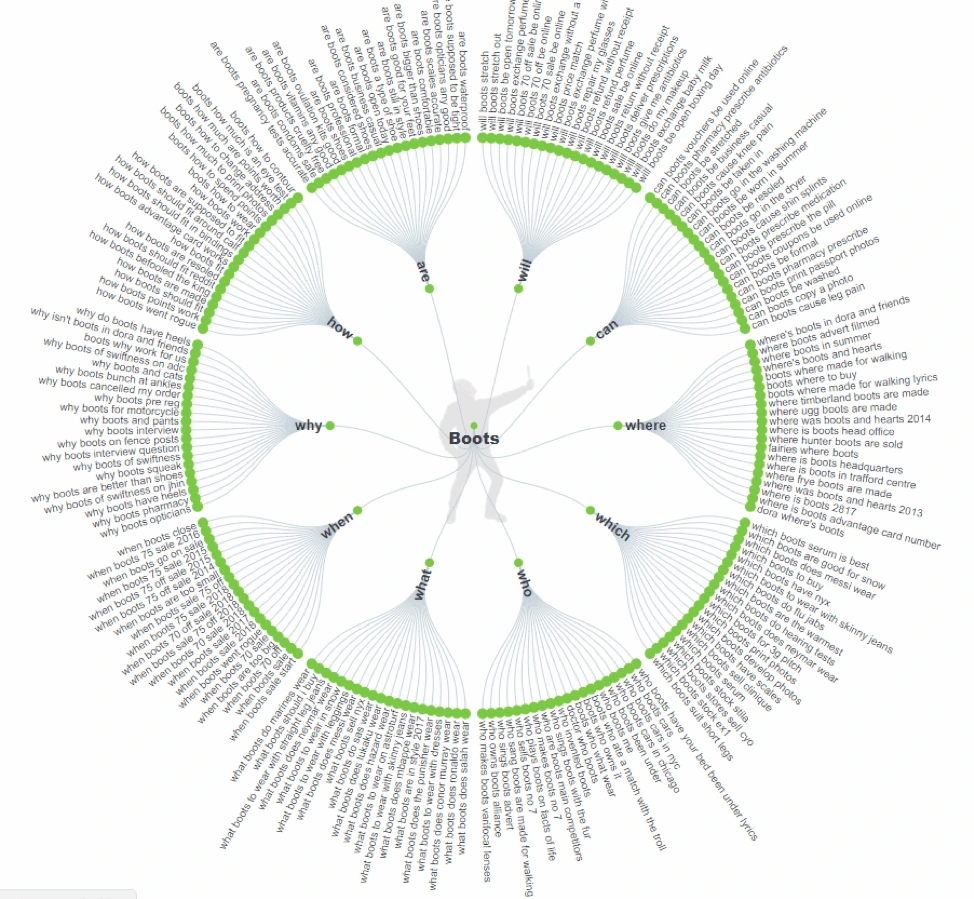
Answer the Public gives you the most popular questions about a topic—things your potential customers might be curious about. One way to use this information is to craft email subject lines that allude to one of these questions, then answer the question inside. This will make them far more likely to click on links and engage with your emails.
8. Litmus
Besides the common email automation features, Litmus offers spam testing. Getting your email caught in a spam filter essentially wastes all the time and effort you spent getting customers to sign up and subscribe, as well as the time and money spent crafting the email itself.
Litmus’ spam testing goes through your email and checks for anything that will trigger spam filters, so your email is ready to send out—as seen in this preview on their website.
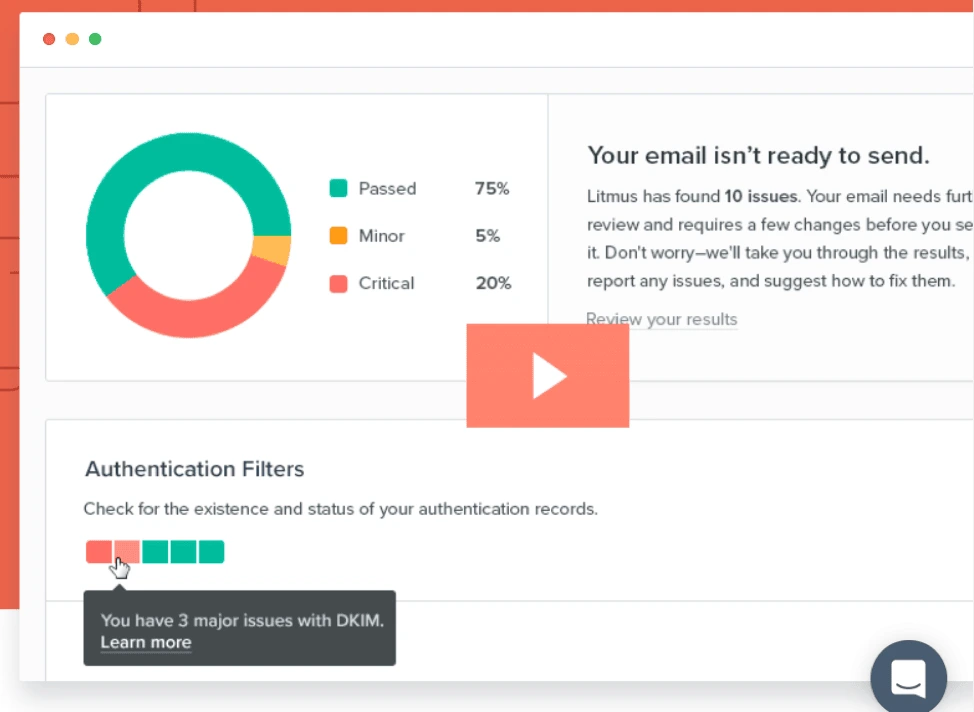
Don’t let your emails get caught on the wrong side of the spam filter. People aren’t going to search through their spam folder to find your newsletters; they’ll likely forget they even subscribed to your content.
Key takeaway
We hope these tools give you guidance on how to effortlessly navigate through the world of email marketing. Email is essential for marketing consistency and commitment, which are some of the most important principles of persuasion marketing.
Ready to wow your audience with beautifully designed newsletters? Lucidpress will help you send the right message.
According to Email Marketing Industry Census 2018 by Econsultancy and Adestra, 74% of client-side marketers rate email as an effective marketing channel based on ROI. It’s one of the best ways to reach out to your prospects and generate more conversions.
Related: 11 things to consider before your next email campaign
To use email marketing to its full potential, here are 19 effective best practices to get more responses from your target audience and entice them to take action.
1. Reach out with a purpose
When composing an email, think about what you want to achieve—and from there, decide what information you should include in your message. Going in with vague ideas will most likely lead to confusion and miscommunication, so make sure your emails are always driven by purpose rather than the calendar. Or, put another way: it’s okay to send fewer emails if it means the emails you do send are more impactful.
Each email you send should serve a singular, clear purpose. Asking your audience to do too many things at once will result in them doing nothing at all—an unfortunate side effect of the choice paradox. With one strong call-to-action, you have a much higher chance of persuading your audience to take the next step.
2. Put yourself in their shoes
Step back and take a look at the email you’ve composed. Would you appreciate this email if it arrived in your inbox? Does it offer something informative, entertaining or valuable? If not, you still have work to do.
Here’s an idea: present a problem to the reader and solve it in the email. If you’ve done your homework, you should know your target audience’s desires and pain points. Speaking directly to their experience will be far more compelling than simply advertising your latest sale or blog post.
3. Make it easy for subscribers to contact you
Many times, emails are sent from a “no-reply” address that leaves no way for subscribers to respond. This means you’re missing out on valuable feedback from your readers. Instead, send your emails from an address that accepts replies. It doesn’t have to be yours—consider setting up a shared inbox for an address like marketing@domain.com or blog@domain.com.
Encourage subscribers to get in touch with you, or request a reply through email. However, make sure someone is available to promptly answer them before you implement this.
In all of your emails, include the name of your company along with the physical address, phone number, company website, and links to social media profiles in the footer.
4. Work on your subject lines
Your subject line is like the trailer of a movie. It strongly influences the first impression your subscriber will have of your email. Obviously, you do not get another chance at this. The more interesting the subject line is, the more likely a recipient will open the email. According to research, 33% of people open an email based on the subject line. Use a personalized and compelling subject line that would tempt your readers to find out more.
Short subject lines work best for achieving better open rates. You could even try using emojis to grab your subscribers’ attention. Test your subject lines to see which pulls a better conversion rate and sells more.
Refrain from using buzz words like “You earned” or “Congratulations,” because their overuse leads users to think it might be spam. Be truthful about what you are offering, and let the subject line shine to reveal the real value behind your message
5. Have crisp & engaging email copy
Personalization is an integral part of effective email marketing. Incorporate the principles of personalization to draft relevant, tailor-made emails that match the buyer’s persona and each stage of the buyer’s journey.
For example, if a subscriber has just signed up, it wouldn’t make sense to send them your pricing structure right away. Instead, you can send a welcome email accompanied with a content resource that addresses their probable challenges & pain points—and how you can help resolve them with your product or service.
Avoid technical jargon as much as possible. Rather than describing the features of your product, talk about its benefits. Try to build personal rapport by appealing to the reader’s emotions.
6. Don’t use too much special formatting
Formatting has a remarkable psychological effect on a reader. Use bullet points or numbered lists to organize your content and make it more readable. Refrain from using various fonts and colors—instead, stick to one or two of each. Only use bold, italic or underline to emphasize important words in the copy. The simplicity makes your brand look more professional, and it’s easier to read.
7. Adhere to the brand guidelines
If you want to build a credible brand personality through emails, follow the brand guidelines. In particular, pay attention to the sections on voice & tone. Send frequent emails that are in sync with your personas, business type and industry. Regular email communication will ensure that your brand remains at the top of your subscribers’ minds—but consistency will keep your brand message strong.
8. Create mobile-responsive emails
Responsive emails that function and look great on mobile devices have become almost mandatory. According to a study, 63% of US consumers will delete emails from their inboxes if they don’t open on mobile. Even worse, what if they read your email and want to act on it, but the design prevents them from doing so? Either way, you lose your mobile audience and end up hampering your email response rate. Make sure any outbound links or downloads are accessible via mobile, too. Responsive design will help you reach readers on any browser or device, so your marketing doesn’t go to waste.
9. Use a persuasive CTA
The ultimate goal of a marketing email is to convince subscribers to click on your CTA and take the next action. A strategically placed CTA button with clever copy can make all the difference in your campaign. Experiment with different colors and phrasing. Try action words instead of the standard “Click here.” It’s far more compelling to click a button that says “Download now” or “Get my free sample!”
(And remember: your CTA should be easily tappable on mobile devices, too.)
10. Automate your email marketing
Starting from the time a prospect signs up on your website, and continuing past the time they become a customer, you should trigger-send emails to them according to their interaction with your brand.
When a prospect downloads any resource from your website, you can send them relevant emails to follow up on the content and entice them to respond. Because they’re directly connected to actions a subscriber has taken, these automated emails often have higher open and click-through rates. These emails even give you an opportunity to upsell, cross-sell, re-engage inactive customers, and create a customer loyalty program.
11. Keep it simple
Simplicity and straightforwardness are two key elements of an effective email marketing campaign. Emails shouldn’t be overly cluttered with design elements, but they also shouldn’t be so sparse that they fail to grab attention. Go for a healthy balance between the two and create a comfortable design that pleases the eye. As for the copy, remember that you are talking directly to the reader through this email, so make it conversational but stay professional.
12. Measure performance
We’re in the era of data-driven marketing. You must measure and record the data generated by your email campaigns—not just to see how well you did, but to uncover insights on how to do better. Overall, there are four major elements you should be tracking in an email campaign: opening rate, click-through rate (CTR), bounce rate and response rate. With this data in hand, you can start to measure trends, tweak your strategy, and gain key insights about the reach of your newsletter and how it’s perceived by your audience.
13. Use gorgeous images
Images are a surefire way to make your newsletter more appealing to an audience. The human brain processes visual info much faster than text, and those few extra seconds can make or break the difference between an email that gets read and one that gets deleted. So, choose your images wisely.
Custom graphics in particular offer an opportunity for memorable branding. Follow your style guide to match colors, icons and photography styles. Pay attention to the tone and voice your images convey as well. Stock photos are a fine shortcut, but only if they reinforce the look and feel of your brand. If you’re worried about spending too much time on your images, use a tool like Lucidpress to set up editable templates, then switch out the text and graphics as needed.
14. Try animated content
Animated content is popular with readers, but many brands still haven’t mastered how to use it. If photos are more expressive than text, then videos and GIFs are even more swift at relaying the message. GIFs are also a great way to provide a snippet of a larger video.
You can make the tone of your newsletter lighter by adding GIFs in the body section. Initially, GIFs were almost always used to add humor to content. Nowadays, you can use them in many ways, such as showing how your product or service works. However, there are some drawbacks for animation enthusiasts who are planning to use GIFs in their next email:
- Several versions of Outlook do not support animated content. (Oh, Microsoft.)
- GIFs have larger file sizes, which might slow down the loading speed of your newsletter on older devices.
- If used incorrectly, your brand can come across as insensitive or insincere. Consider asking a few people to read your email before you send it, to make sure your tone comes across as intended.
15. Consider timing
It’s been estimated that most emails are read by people in the evening, the time when they are most free. It may seem counter-intuitive, but sending an email later in the day could result in a higher conversion rate because readers have more time to follow your message.
Since most marketers work during the day, you can use a scheduling tool to do it for you. According to Accelq: “Automation should be integrated into the overall lifecycle, and not a ‘test automation’ silo.” The more you can automate, the less you have to babysit.
16. A/B Test
Any kind of marketing strategy that aims to increase conversion rate should be tested. A/B testing is the easiest (and cheapest) way to check the effectiveness of your strategies.
Testing will help you develop a clear idea of how a campaign is going and how you can improve it in the future. Email marketing campaigns can be hugely successful when you start testing and tweaking any flaws in the interface. You can also validate your hypotheses for things like CTA buttons, images, time of delivery, and landing pages. Here is a comprehensive starters’ guide for A/B testing your emails.
17. Segment your audience
It’s an unfortunate reality: most people who sign up for your newsletter are not going to open it. How do you encourage them to open the email and convince them to convert? Sometimes, you need qualitative data to find out. That’s right: send them an email to find out why they are not opening your emails.
Sound futile? It doesn’t have to be. You can offer incentives and promo codes to lure them in. With the results, you can set up audience segmentation to ensure that various user personas are targeted differently through your email marketing campaign.
If an email survey doesn’t sound like your bag, you can also collect this data via phone calls or personal interactions with your customers. Regardless of how you do it, you need to create targeted, personalized emails for your readers. “One size fits all” doesn’t work anymore. [ ]
18. Build relationships
When someone subscribes to your newsletter, they’re agreeing to an ongoing relationship with you. You need to show that you value them, that you care about their problems and choices. This applies to every part of your email: the graphics, the copy, the offer, the tone. Use your findings to consistently improve your email campaigns and serve your customers better than before. Build a relationship that makes them proud to be your brand’s loyal customer.
19. Proofread and test your emails!
So many people forget (or choose not) to do this, leaving mistakes in their content which make them seem unprofessional. Definitely not a good look for anyone, this can be prevented with a simple process called… proofreading. Simply reading your work goes a long way toward catching any grammar mistakes you have made, which will save you a load of embarrassment. No one wants to discover that they misspelled a word in an email to their entire customer base.
How about another pair of eyes? If you want someone to see it fresh, you can ask someone else to do it. You could even hire an online freelancer to get help from a highly qualified person. Sure, it costs money, but it might be worth the peace of mind to know your emails are top-notch.
Finally, send yourself a test version of your email. See how it looks in different browsers and on different devices, including desktop and mobile. A formatting error which is unnoticeable in Chrome might be egregious on iOS, so it’s better to cover your bases before you hit send.
Key takeaway
Getting more responses to your marketing emails is not an impossible goal. With the right techniques, you can stand out from the competition, create lasting impressions of your brand, and build relationships with your readers through their responses.
Kickstart your next email marketing campaign with our free newsletter templates.
If you’re among those who think email marketing is too old-school to be effective these days, you’ve got the wrong idea. Email marketing is still a powerful tool that can help your brand shine.
Related: 8 tips to get more responses to your email marketing
What makes email so effective is the fact that it’s a permission-based marketing channel, one that gives you a chance to reach customers in a personal place—their inbox.
When a prospect signs up for your emails, they’re expecting a welcome email that introduces them to the brand. As this is the first email your subscriber will receive after being added to your email marketing list, it’s crucial to do it right.
9 best practices for your welcome email
1. A timely introduction
Your new subscriber wants to know more about your products & services at the time they sign up for your emails. Take advantage of their interest by sending out a welcome email as soon as they sign up. If you miss out on this opportunity, there’s a real possibility that the subscriber will forget about you and lose interest in your brand.
2. Crisp subject lines
All the work you put into crafting an engaging email will be for naught if your email doesn’t get noticed in a crowded inbox. Add an extra zing while crafting the subject line for your welcome email.
To make your email feel more personal, try using personalized subject lines. People are attracted to their own names, so this will lead to higher open rates. Here’s an example from Google:
Subject line: Smiles Davis, Welcome to your Google Home Mini

3. A pleasant greeting
Greet your new subscribers with a warm welcome email that’s personalized to their interests and preferences. Even when you’re sending automated emails, you can write them in a way that feels personable and real—like they’re coming from a human being and not a robot. Consider using an employee’s name and picture, so subscribers can visualize who’s behind the emails they get from you.
4. Guiding them through the next step
Making your customers wait too long isn’t good practice. You’ll have far better results if you intentionally build brand loyalty and guide customers through the purchase process.
For example, if you’re an online cosmetics brand, tell them why they should choose your brand over the many other brands in the market. Give them an overview of your products and how they can browse your app or website to find the cosmetics they want. If there are other actions you want them to take, spell those out as well—like in this example from nDash.
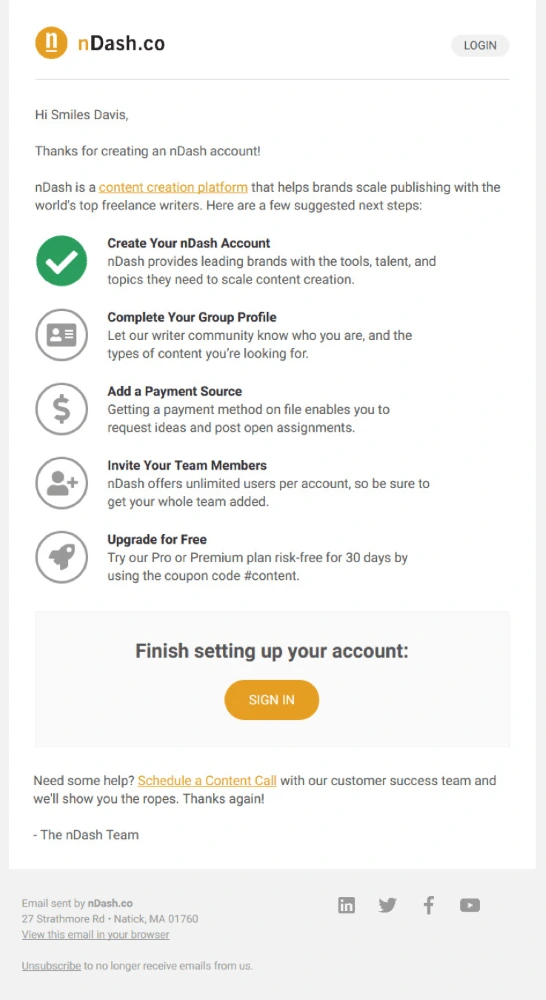
5. Include freebies in your welcome email
This is your chance to win over new subscribers with low-cost goodies. People love free stuff, so this will endear your brand to them right out of the gate. If you can’t afford to give away items for free without a minimum purchase, consider including a discount or promotion instead—such as a percent-off coupon or a buy-one-get-one promo code.
6. Hit two goals with one email
According to email marketing best practices, it’s recommended to include links to your social media profiles in your email. Ask them to like or follow you on the platforms you use most.
This is an especially clever move for e-commerce brands, since they need a strong audience to build their reputation and provide social proof. Even if you’re not an e-commerce brand, you can build buzz and loyalty by directing subscribers to your social channels.
7. Ask to be whitelisted
Being whitelisted can enhance your deliverability rates and make it easier for subscribers to find your emails in the future. It also helps to keep your emails out of the Spam folder. See how Travelocity asks people to whitelist them in the section titled Subscription Information:
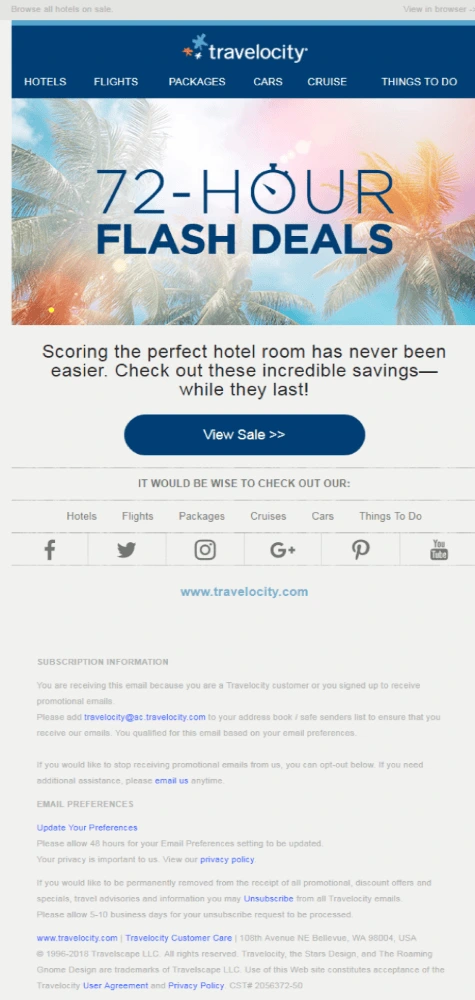
8. Give them a way out
You should always give your customers the option to unsubscribe from your emails at any point. By doing so, you’ll retain genuine subscribers in your list—people who are actually interested in reading your emails. In turn, your engagement metrics will rise, because you’ve eliminated those who aren’t interested in purchasing from you. (Also, unsubscribes are always better than spam complaints.)
9. Include free shipping
For e-commerce brands, one major obstacle your subscribers face while shopping online is high shipping charges.
Ease that friction and encourage first-time buyers by offering free shipping on their first order. Try mentioning it in your welcome email to delight your new subscribers. Creating a happy customer at the onset goes a long way toward building loyalty for your brand.
Mantras to keep your welcome emails engaging
- Pin your top content
Play your cards right with a welcome email that features your best content and gets them excited about your brand for the long haul.
- Avoid no-reply
Do not send your emails with a no-reply email address. It feels impersonal, and it’s important to assure your subscribers that you’re listening to them. They should know there’s a person behind the email ready to hear their problems and feedback.
- Make it compelling
Make your email compelling with content. Welcome emails should catch the subscriber’s attention from the moment they open it. If you’re struggling, try adding a dash of fun or humor to your email. Include interactive elements like GIFs, accordions, cinemagraphs or videos to make it more visually appealing.
- Build anticipation
Create a sense of anticipation with your welcome email. Don’t spill all the beans right at the beginning. Each email should leave the subscriber waiting for the next one. Find a way to highlight your best content and maintain curiosity in your subscriber’s mind so they look forward to hearing from you.
- Try a welcome email series
Instead of just sending one email for the sake of formality, consider sending 2-3 welcome emails as a series to initiate your subscribers. In a welcome series, you can introduce and explain different pieces of your business and entice subscribers to purchase from you.
- Write accessible emails
With one billion people in the world living with some form of disability, it’s incredibly valuable to write accessible emails that can be understood by everyone who receives them. Think about all the ways people might interact with your content—for example, different devices and browsers. How does your email sound when it’s read out loud to a blind audience? What does your plain text email look like? When your message is more inclusive, you have a wider audience to nurture.
Key takeaway
Welcome emails are an excellent opportunity to introduce subscribers to your brand, encourage purchases, and lay the foundation for loyalty down the road. Make sure you include all these essential elements in your welcome emails to set your brand up for success.
Kickstart your next email marketing campaign with our free newsletter templates.
Since 2008, real estate has gone up by an incredible 11.4% and created a fantastic opportunity for real estate agents to sell more clients.
Millennials will quickly become over a quarter of the real estate market, and only 1% of those millennials didn’t search online while looking for a house. Just one percent.
Related: How to handle inbound real estate leads
The internet has forever changed the way real estate agents get leads for their business, and you’re definitely behind the curve if you haven’t optimized your website for lead generation.
How do you generate real estate leads online? In this guide, you’ll learn various methods for obtaining quality leads online and the secret to converting your website into a real estate marketing machine.
Let’s get started.
1. Social media
If you’re not a frequent user of social media, it’s time you got started. Most people have a Facebook account, and many are active users on Instagram as well.
Instagram in particular is a fantastic avenue for sharing high-quality images and videos of properties and advertising your latest content (e.g. blogs & newsletters) effectively. By engaging with different channels each day and adding value to others, you’ll begin building a devoted following online.
Lots of real estate agents don’t do social media because they lack time for it. But with tools like Buffer and Hootsuite at your disposal, you only need an hour to set up a whole week’s worth of posts. All that’s left is checking the comment threads and responding whenever you have a few seconds throughout the week.
Read more about social media for real estate: How to build a social media campaign for real estate
2. Website
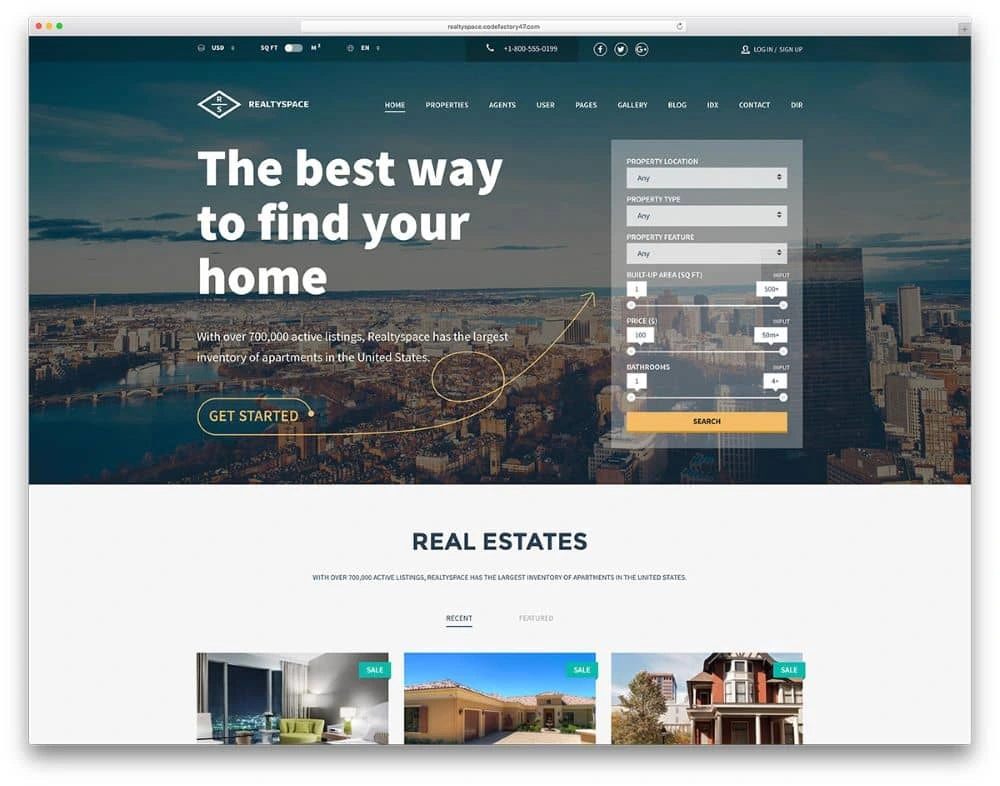
Source: Colorlib
If optimized properly, your website could be the foundation for attracting real estate leads online. It gives you the ability to provide value to your target market and help them engage with your brand.
Many real estate agents make mistakes in this area, and your website is not the place to describe your greatness in detail. Make your copy about how you’ll add value and better the lives of your customers.
An easy way to check whether your website is focused on your target market is to count how many times your site uses the word “we.” Customer-focused websites will use the word “you” more often.
3. Newsletter
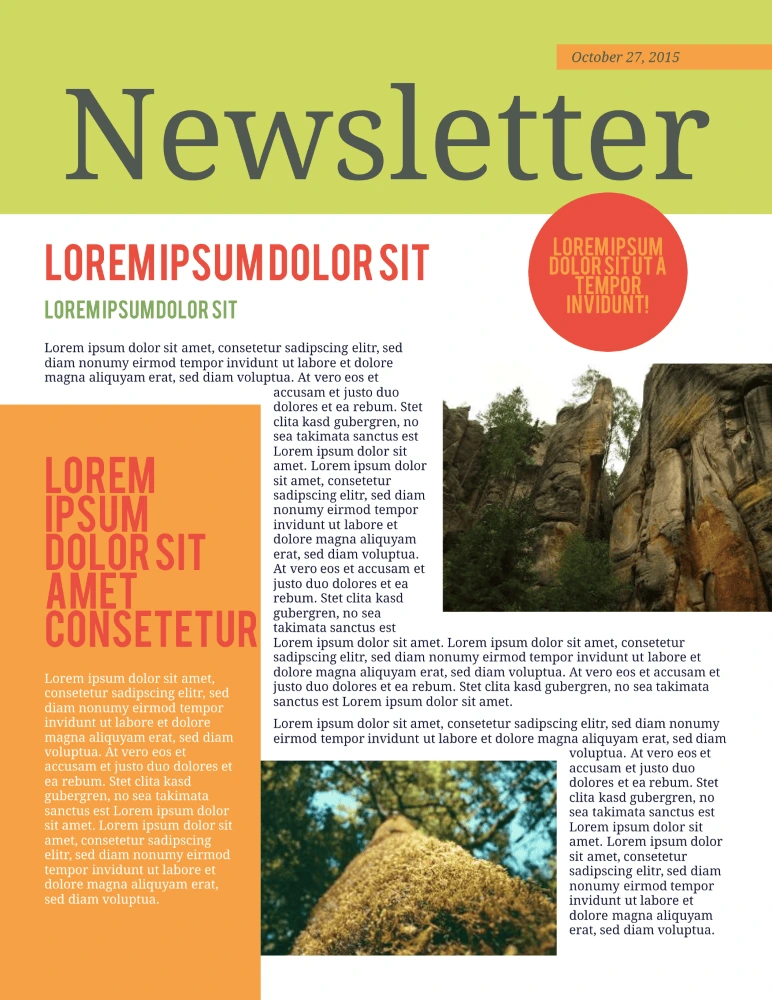
See more newsletter templates from Lucidpress
It’s always a good idea to keep your name top-of-mind, and a newsletter is a great way to do so. Newsletters can share real estate news, recent listings, and tips to deal with typical homeowner struggles—like preparing your house for the winter.
A newsletter is especially useful if your leads live in urban areas. Cities such as San Francisco, Los Angeles and Chicago are massive and busy, so it’s easy to miss out on events if you’re not paying attention. It’s also an excellent opportunity to inform subscribers about the latest news and events in their area.
Read more about newsletters: 13 best newsletter design ideas to inspire you
4. Blog
Blogging is one of the most popular and effective ways to generate leads online. But like any lead-generating tool, it has to provide great value to your target market. A blog post about the staff holiday party is not going to get the leads you want.
The best information to share with your target market is actionable. This could include topics like making a down payment, picking a lender, listing their home, and working with a real estate agent.
Free advice will grow your influence and make you a valuable resource—so when someone needs to sell or buy a house, they’ll think of you first.
Read more about blogging for real estate: How to use content marketing in real estate
5. SEO
The first page of search results has only ten slots. 33% of the people searching will click on the first result. 18% will go a step further and click on the second result. The further down the page you go, the fewer clicks there are—only 4.4% click on the sixth result.
That’s why every business wants to be on top. The lower you are, the harder it gets to attract your target market’s clicks.
The ideal SEO strategy is about finding the best keywords (and phrases) to target, then using them deliberately in your content to attract the customers you want. SEO powerhouse Moz has lots of free resources and tools to help you get started.
6. Video
If seeing is believing, then showing off the fantastic features of your properties is a surefire way to win converts—and there’s no better way to do that than with video.
Videos empower your potential clients to take a guided tour of your properties. They’ll be engaged by your content, but more importantly, they’ll be motivated to reach out for more information.
A video is far more than just a slick way to show off a property. On average, an online video converts 33% of leads. If you want a more captivating way to connect with your target market, video marketing is a great way to increase interest in your properties.
Read more about video marketing for real estate: How to create stellar videos for real estate listings
7. Influencer marketing
Connecting with others in your industry is always wise, and doing it online makes it easier than ever. You can share and amplify each other’s work through social media and comment on posts each of you publish.
Influencer marketing takes this one step further. It starts by figuring out who your target market is—specifically. Then, you can find influencers who are popular among the folks you want to target. By partnering with these influencers on advertising campaigns, you can reach wider audiences and attract more people to your brand.
Read more about influencer marketing in real estate: 5 influencer marketing strategies for real estate
8. Mobile optimization
Industry professionals often spend tons of time and money making sure their website is professional and easy to use… then forget to check how it looks on a smartphone or tablet.
Mobile search has surpassed desktop search, so it’s more important than ever that your website works with mobile devices. (Google is going as far as penalizing sites that haven’t created mobile-friendly layouts.)
Make the switch. Not just to protect your website from Google, but to impress customers who encounter your brand exclusively via mobile device. Aim for the same goals as your regular website: clear copy, attractive design and intuitive function.
Want to go even further with mobile? Read more about using mobile text messaging for real estate: 5 steps to build out your real estate mobile text messaging strategy
9. Referrals
When you start off as a real estate agent (or in any field, really), you won’t have a network. So, it’s up to you to build one.
As you begin to deal with customers, don’t forget to ask for referrals. Encourage them to share your name with others—make it easy and worthwhile for them to do so. Whether it’s to their friends, family or coworkers, advertising by word-of-mouth is powerful. People are more likely to follow recommendations from people they know than an anonymous review online.
10. Retargeting
Although we covered social media all the way at the beginning of this guide, we left out one element that deserves its own section: retargeting via Facebook ads.
Facebook ads are not a popular method of advertising in real estate circles, despite how high the ROI can be. Here, retargeting simply means that people who have shown interest in your brand will see your ad again. This “interest” is measured by actions such as reading your blog posts, clicking on one of your ads, or even signing up for your newsletter.
Your conversion rate will improve if you target people who want what you’re selling. People who are actively interacting with your brand are more likely to buy than those just scrolling through their feeds. Retargeting keeps your brand top-of-mind for the folks who matter most.
Key takeaway
Leads don’t just magically appear in your inbox. You need a strong lead-generating strategy that helps you cultivate interest in your brand and set you apart from the competition. These tips should get you on the right track to generating real estate leads online.
